December 6, 2017.
Over the last 17 years, the truck has been amazing. Truly a joy every time I get in it, work on it, or even just get all googly-eyed looking at it.
But, as we've started bigger and longer adventures, and turned it into an adventure truck as much as an around-town-mobile, the truck has slowly gotten to a point where it was time to do something about the drive train.
Big Tires = Big Problem
…and by slowly, I mean it was about like this:

And that cliff, right there at the edge, was the installation of bigger tires. See, before that, even with all the extra weight from bumpers and sliders and bed racks and CVTs, the gearing was OK - so I could get rolling easily in first gear, climb up a rocky road without going into 4L, and my gas mileage was still pretty reasonable.
But those tires screwed all that up. I was lugging as I'd start from a stop light, and simple hills would require downshifting to third gear, from fifth. And my gas mileage dropped from ~19 to 14 mpg.
Such is the slippery slope of vehicle modifications, I guess. To more easily go on the adventures, you need the bigger tires, so those weren't going away. Instead, the discussion of what gears to get, and how to get them began.
There were really two choices I had to make:
- What gear ratio to go to?
- How to get those new gears installed on the truck.
Choice 1: Gear Ratio
From the factory, the truck came with a 4.10 gear ratio. Of course putting on larger tires meant that the gears were pushing the truck further down the road (since one rotation of the wheel is now a larger circumference), and so at any given speed, my RPMs were lower by about 6-7%.
To bring those RPMs back up into the power zone (between 2500-3000 RPM on a 1st Gen, V6 Tacoma), I'd need to change the gearing. My choices: 4.56, 4.88, or 5.29 ratios.
5.29's were out - that would be too much gearing for my 33" tires, especially since the truck is still my primary vehicle. Driving around in town would feel like being in 4L, and I didn't want that.
4.56 vs. 4.88 was a tougher decision. For "around-town," 4.56 might be better - it'd get me back to (essentially) stock gearing, but when the truck was loaded for adventure, it might still require downshifting into 4th on hill climbs, and there might be places where I'd have to go into 4L that I may not otherwise. For adventuring, 4.88's would provide that lower gearing and power, at the expense of some "around-town" efficiency of 4.56's. In the end, I decided that the direction the truck is going is towards adventure - and so 4.88's would be the best fit.
Along with that decision, everyone I talked to recommended that I get a front locker as well. I already had the OEM rear locker, and putting an ARB air locker in the front at the same time would be the obvious, economical choice. And of course, it wasn't their money! Lucky for me, I already have an ARB compressor, so much of the work was already done.
Choice 2: How to Install?
In the early days of the truck, the only real work it needed was "regular maintenance" - which for me meant an annual oil change since I drove it so infrequently. With a coupon from the dealer, it made little sense to do any of this myself. But now, I try to do most of the modifications and maintenance myself - both so I can learn more about the truck and so that should something break on the trail, I have a better sense of how to fix it or what it "should" look like.
So, I initially thought I'd partially install the new gears and locker myself. Really, I had several options:
- Order some gears (perhaps through a group buy) and install them myself.
- Order some new, assembled differentials with the gears already installed, and replace the diffs myself.
- Pay a shop to install new gears in my existing differentials.
As I researched thought about it more however, I very quickly realized that #1 was way out of my league. Being one of the more finicky items on the truck, I knew that I didn't have the tools or the know-how to do the actual gear install myself. I also talked to some guys who did have the know-how and did install their own gears, only to hear them say that they wouldn't do it again - they'd pay someone.
Well, hearing that also made me question #2. There are really two reputable places to get gears - ECGS (East Coast Gear Supply) and Zuk in Arizona (Toyota Gear Installs). I liked the Zuk was using Nitro gears, and a quick email exchange with him netted a lot that I liked hearing - he was happy to do both the gears and the locker, and he'd do it for a totally reasonable price. But, there was a problem - he didn't do the actual install on the truck, so I couldn't drive it down for a couple days and "be done." Instead, I'd have to take out my diffs, ship them down, get them rebuilt, and then wait for them to get shipped back so I could reinstall them.
That would mean two weeks of "truck on jack stands" - longer than I wanted (or could really pull off given the lack of a shop). I was also unsure that the front diff removal/install was in my wheelhouse - at least alone.
So that left option #3. It was the most expensive option, but it was also the one with the highest success rate, and the shortest timeframe. I had a great recommendation from Mike @Digiratus for a semi-local shop - JT's Parts and Accessories - and so I gave them a call.
Communication was great with Carl and we worked out a mutually agreeable time and price - I'd bring my truck in when the shop opened on December 6, and I'd drive it home when they were done the evening of December 7. Not too bad, especially since it meant a night in Leavenworth with @mrs.turbodb while we waited. Win win.
Install Day
I was up early on install day, leaving Seattle by 4:15 am. With a fuel stop, that got me to JT's Parts & Accessories just before they opened at 7:00am - perfect timing. I headed in to say hello.
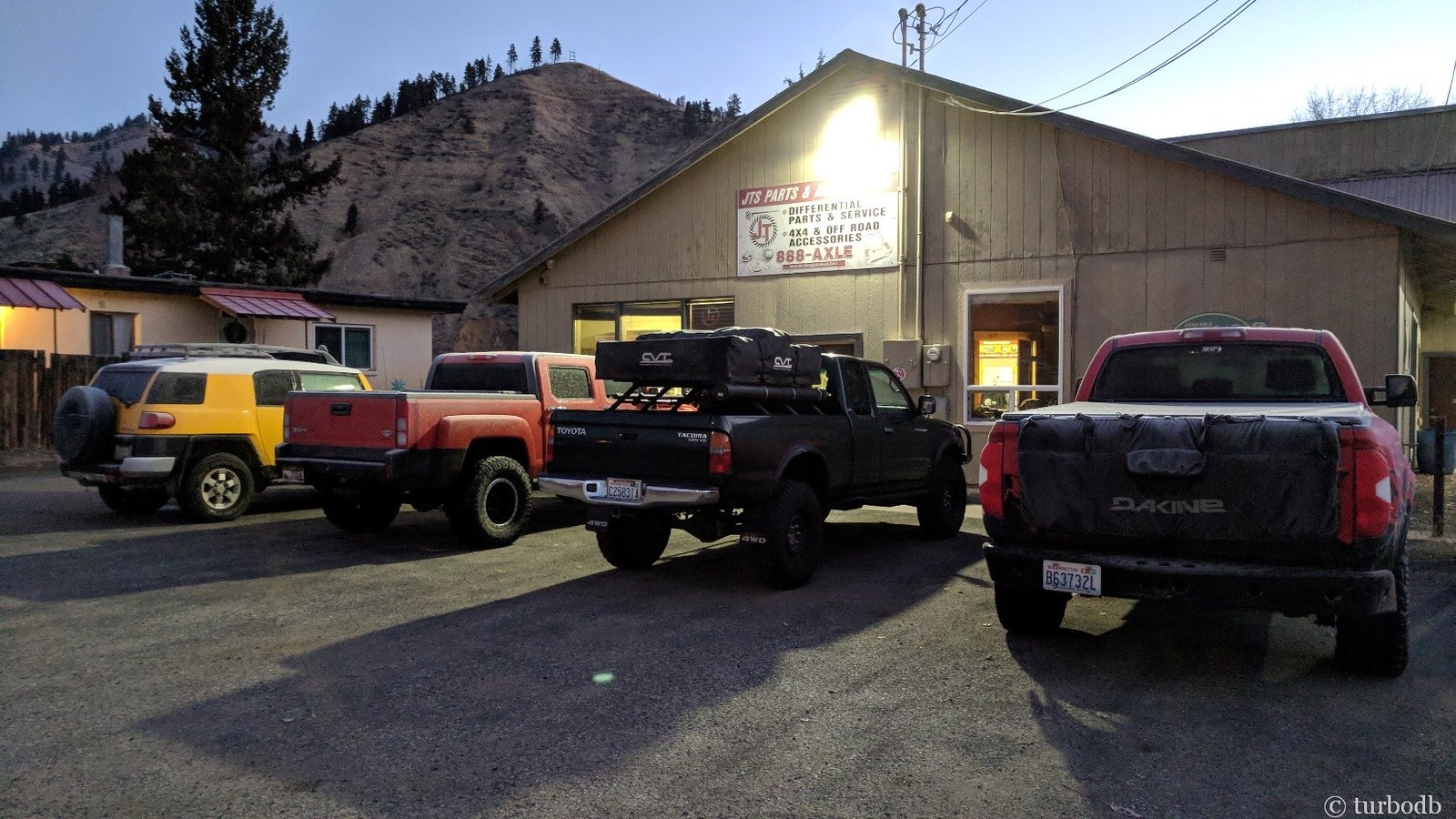
A couple guys were there and let me know that Jared and Chris, who would be doing the work would get started around 8:00 am or so. They suggested I take the short walk into town and grab some breakfast, and then that I was welcome to hang out and take pictures of the work once it got started. Sweet.
At 8:00 sharp, Chris and Jared arrived, and it was time to get started. Into the shop we went, and as they got the truck up onto the lift, I was immediately jealous. I need a shop like this.
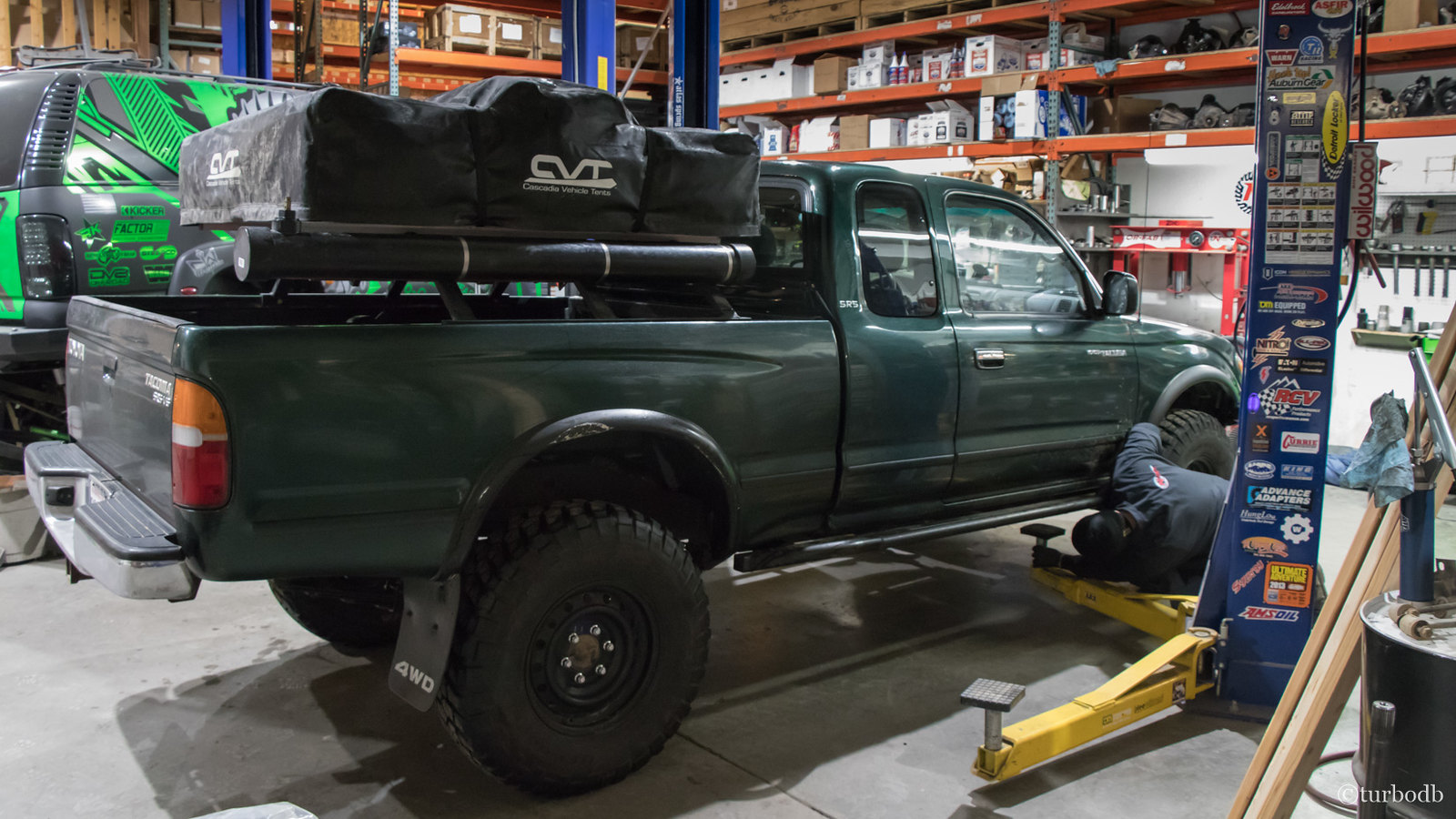
Not losing any time, the wheels came off first, and then the truck went higher.
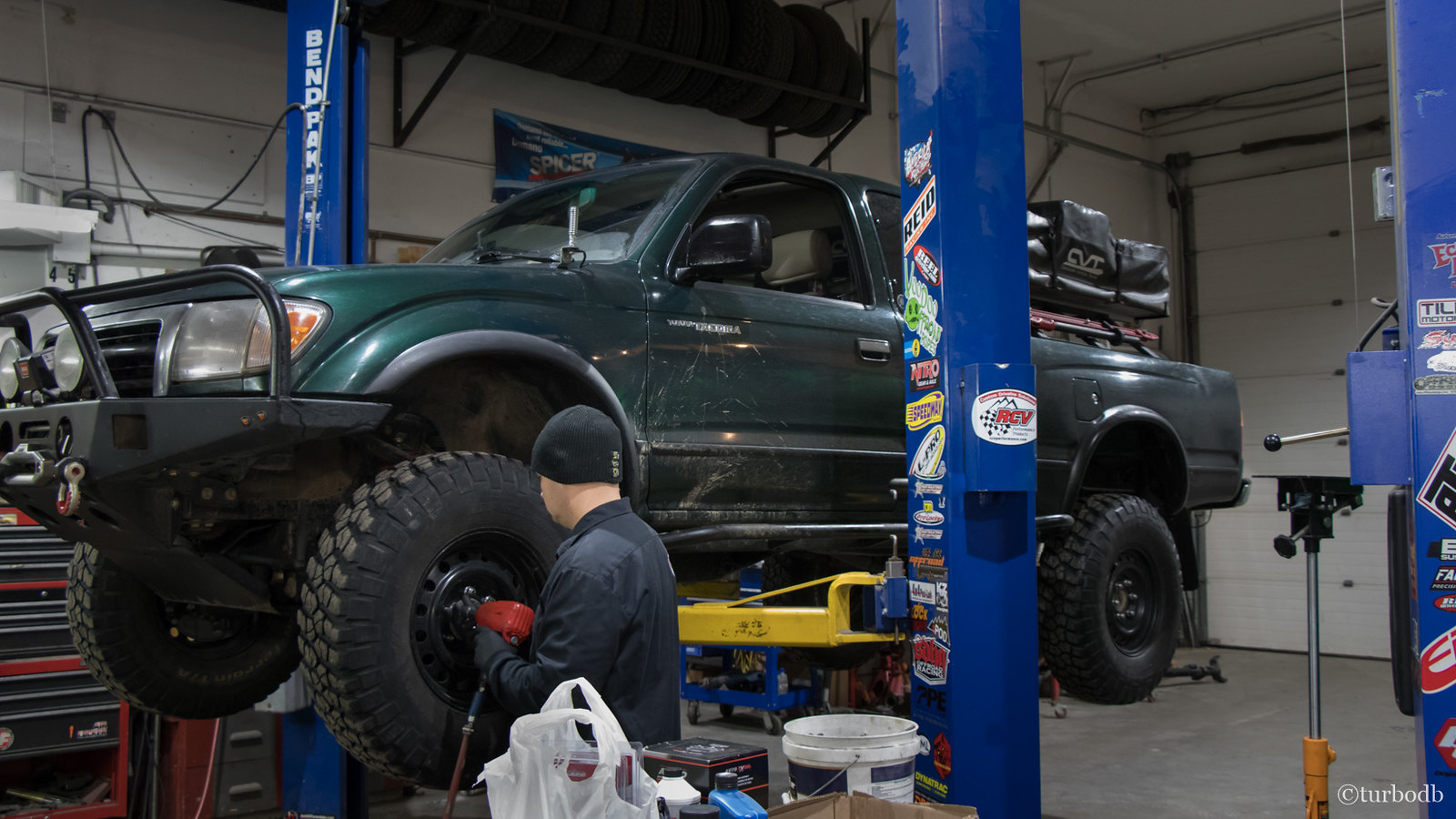
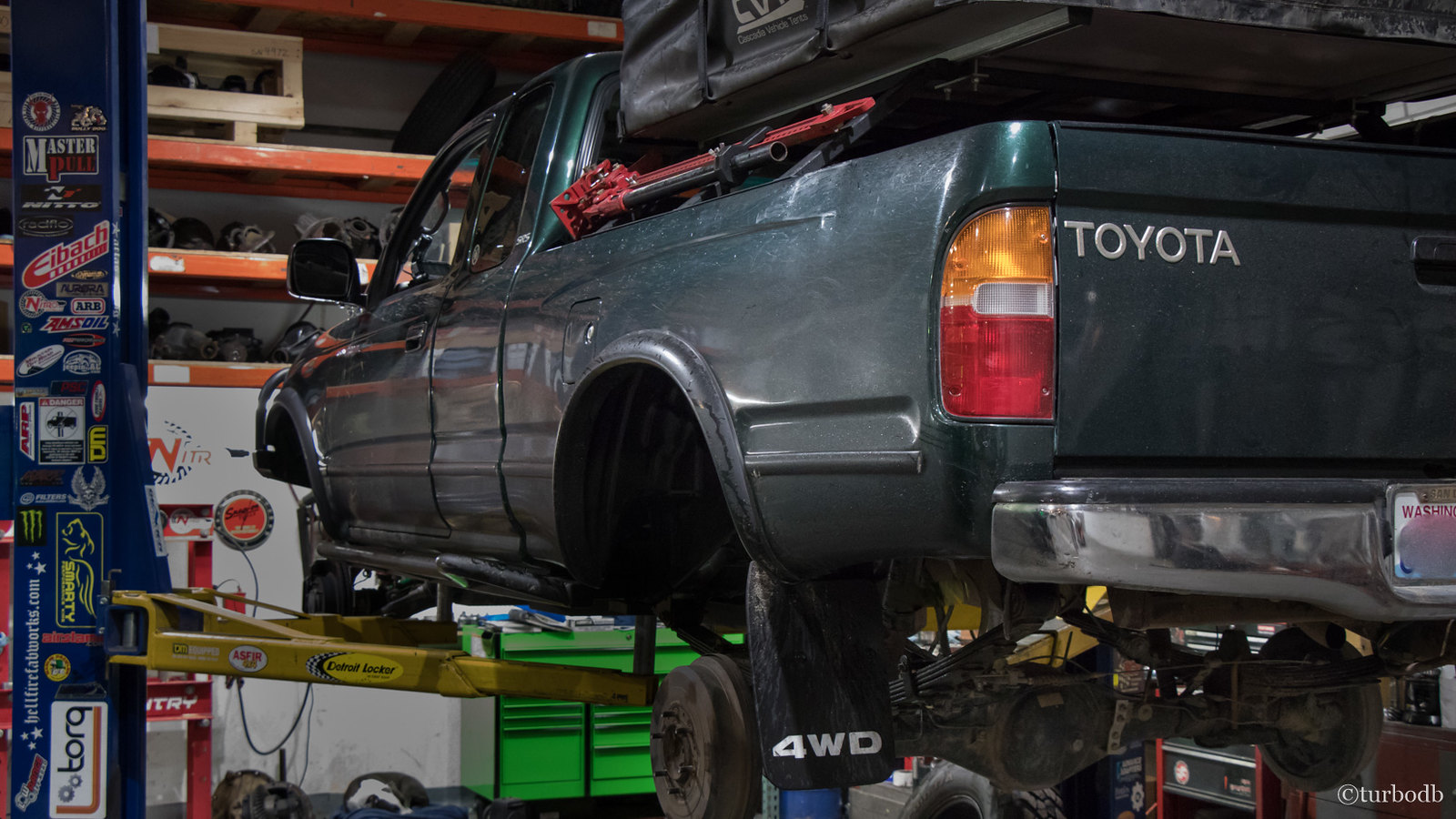
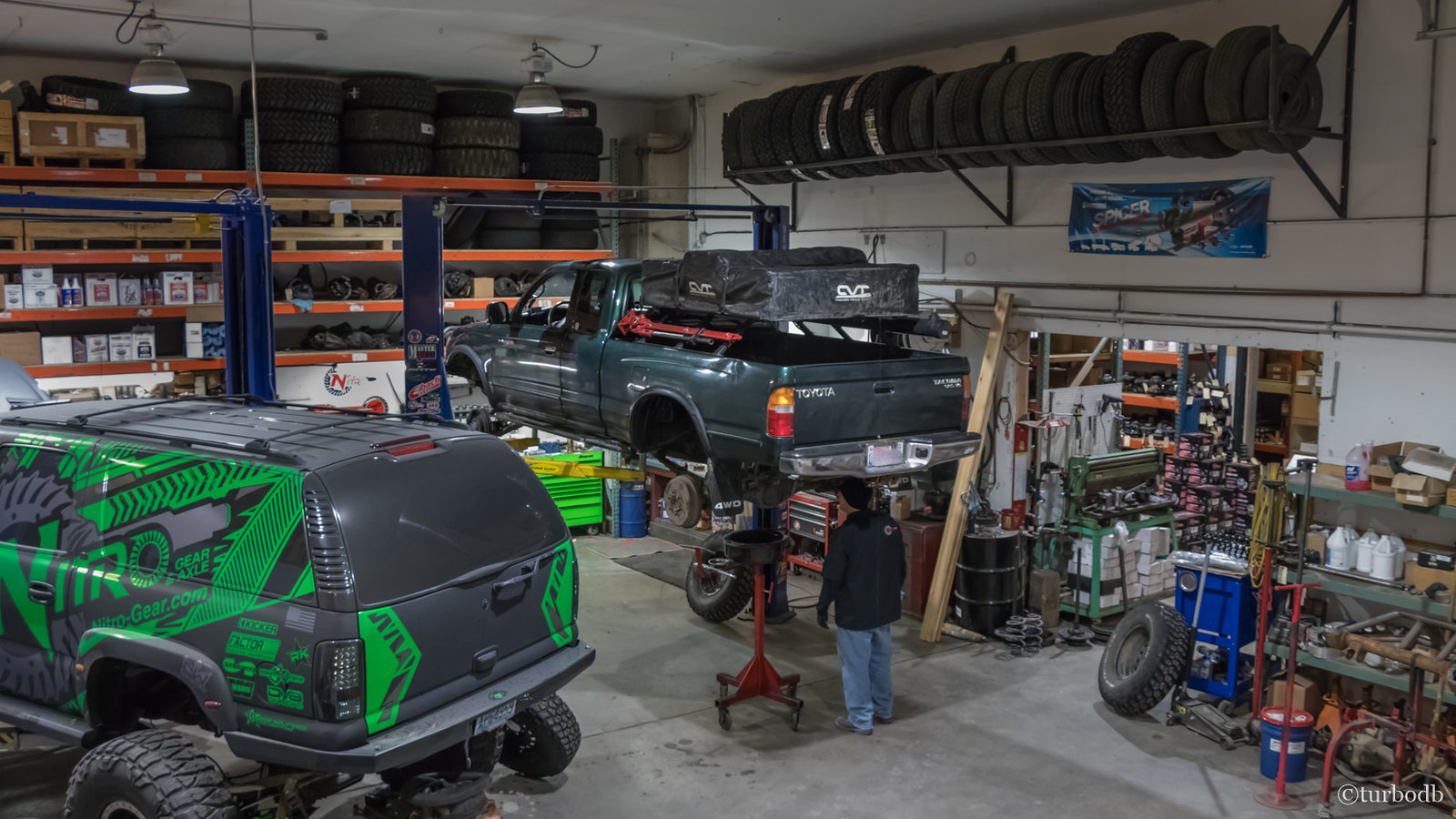
Next, out came the rear diff oil (apparently "weird" on my truck because the drain plug is on the wrong side), as well as the rear axles. Watching Jared work, it was clear to me within the first 15 minutes that I'd made the right call - while I could have wrestled these things myself (though much harder without a lift), it was great watching an expert do it the first time.
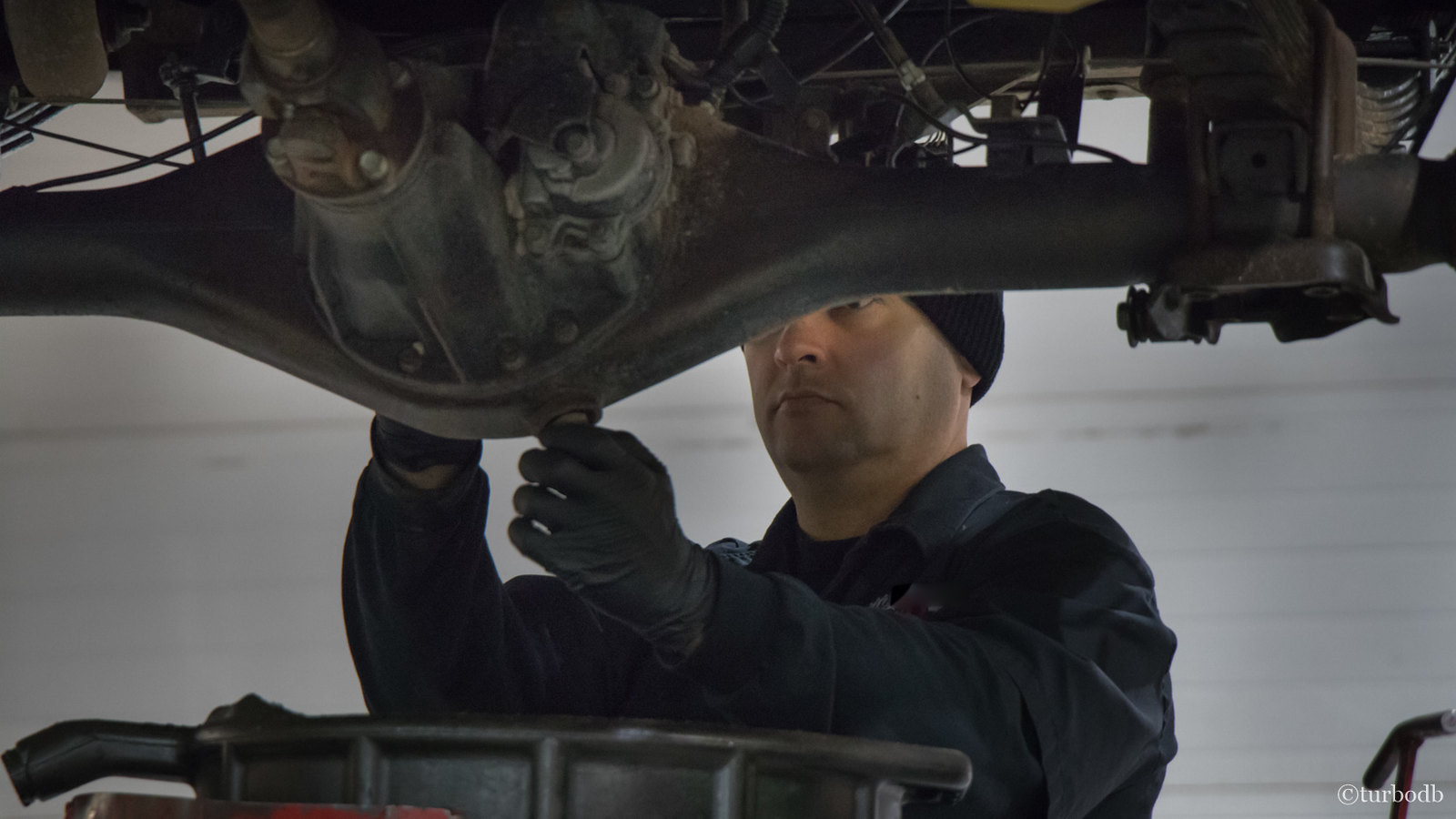

It's not every day you see your drive shaft up between the gas tank and exhaust…
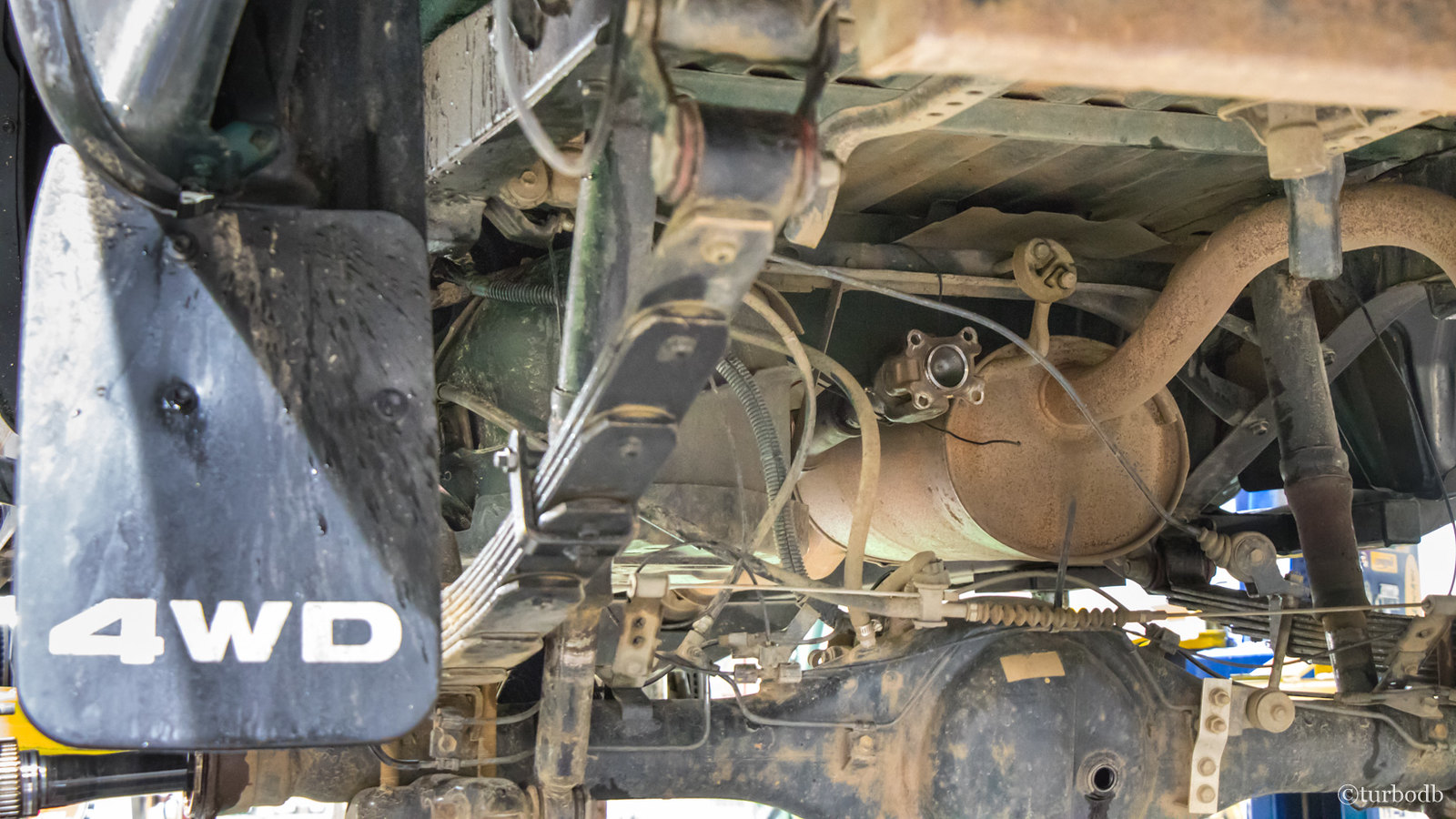
As the rear diff was disassembled and drained, Chris got to work opening the new parts to be installed, and doing the final machining on a solid spacer for the rear diff. Even though these guys do this all the time, it was nice to see Chris excited to open everything in the same way I'd have been - "Oooo, a new ARB!"
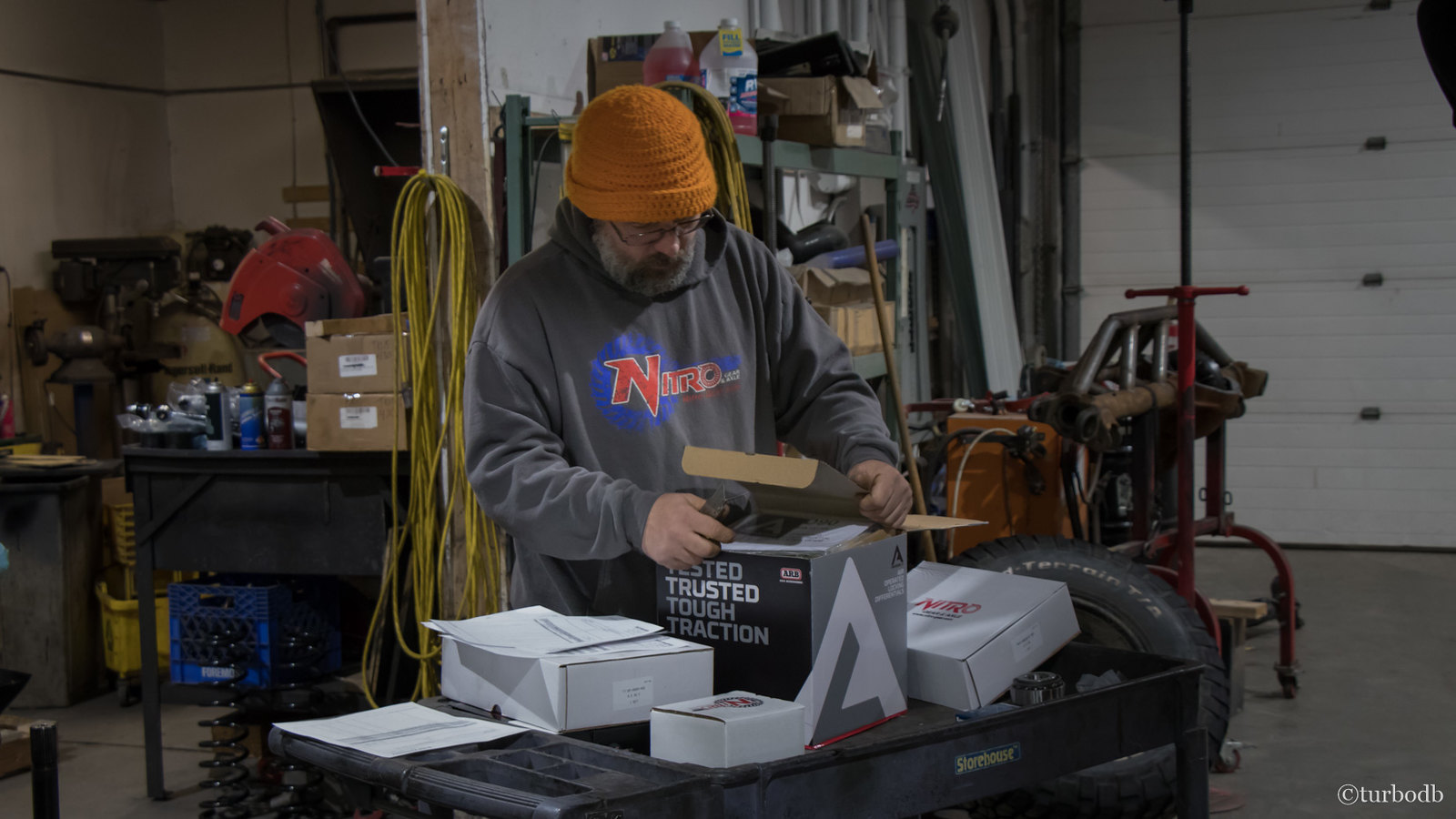
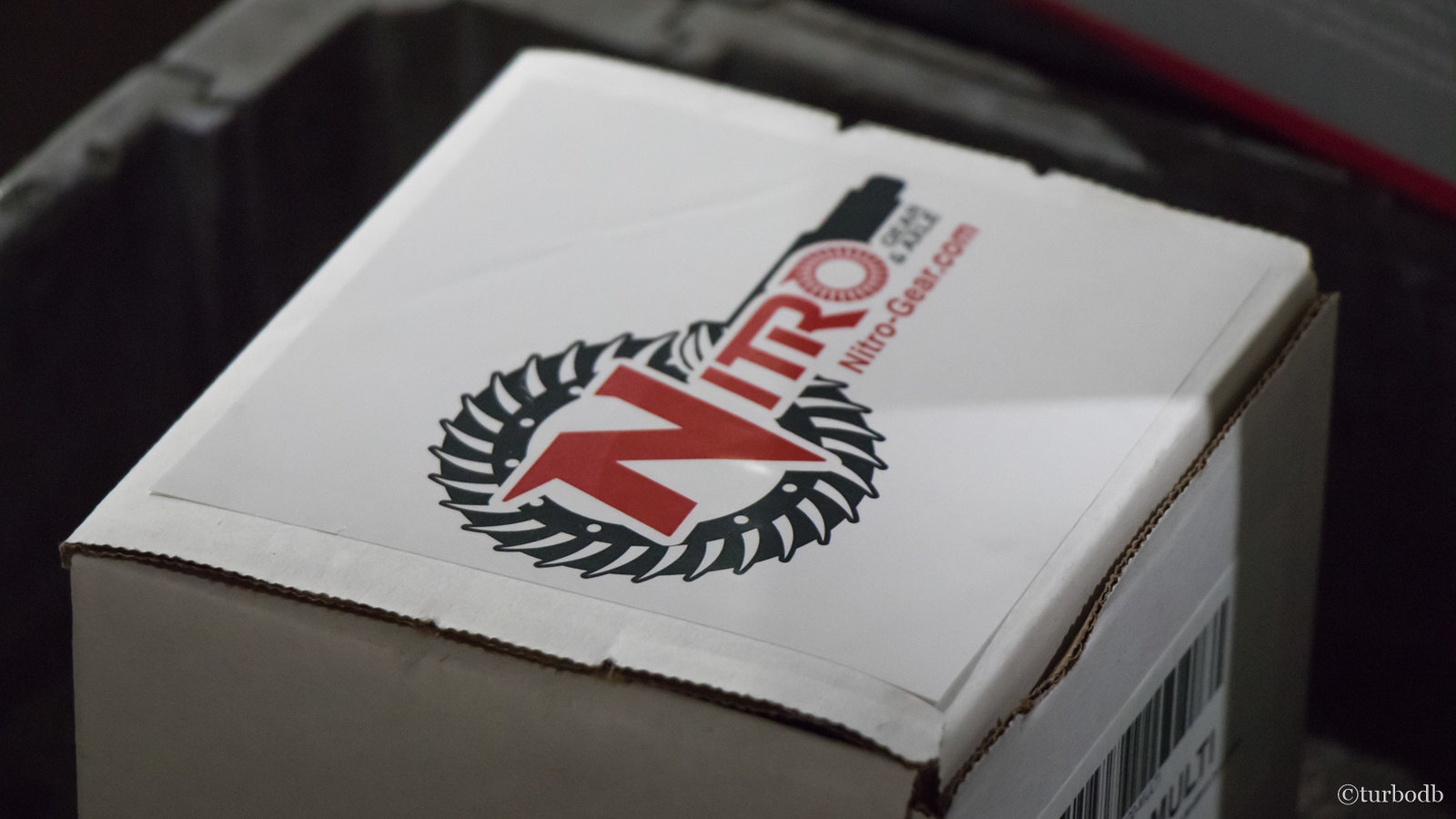
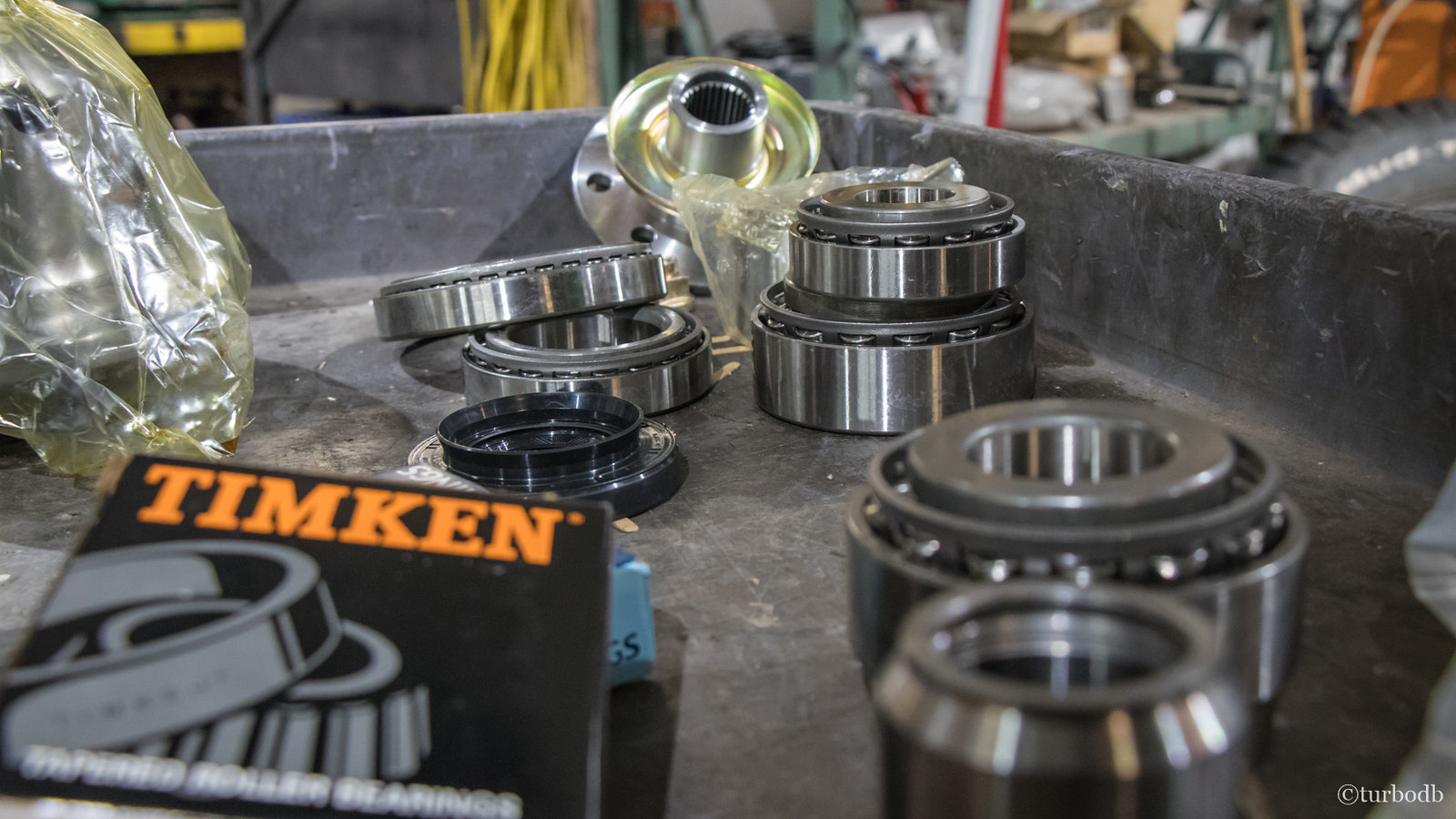

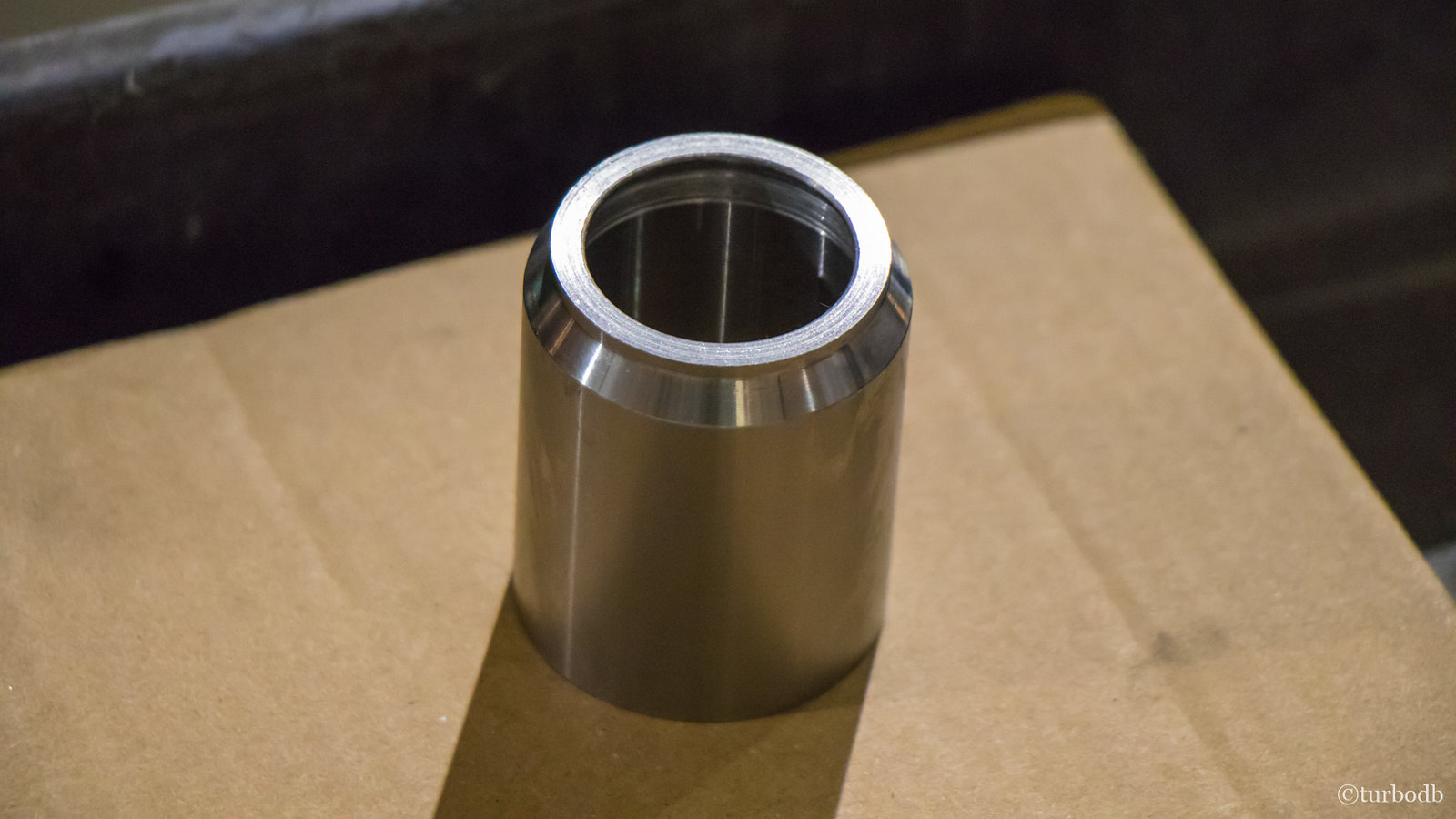
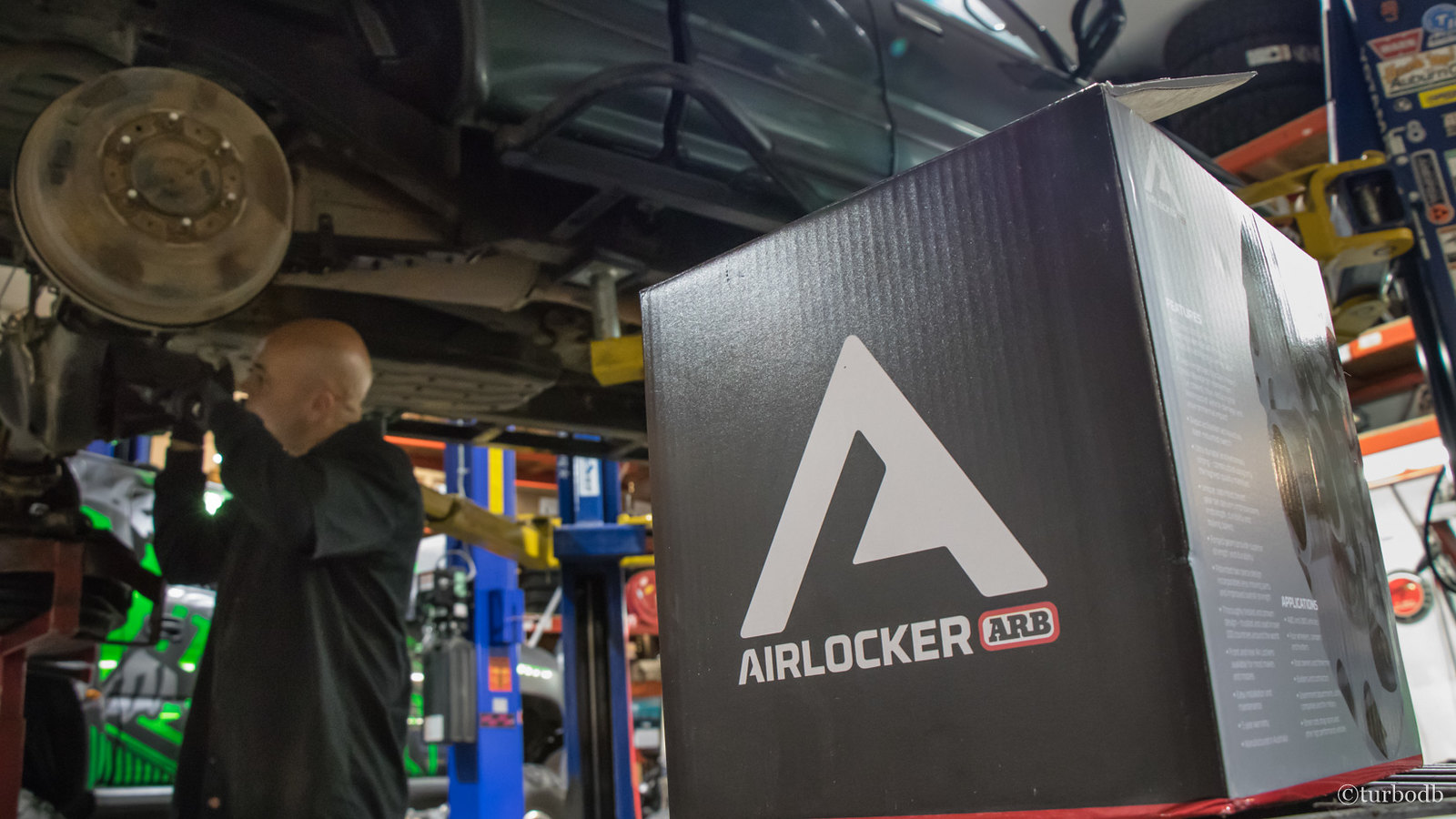
In the end, the newly installed parts were a Nitro 4.88 front and rear gear package (with Nitro rear ring & pinion, Nitro front Master Install Kit, Nitro rear ring & pinion, Nitro rear Master Install Kit, Front pinion pre-load solid spacer, Rear pinion pre-load solid spacer, and Front Yoke) and an ARB 7.5" RD90 air locker for the front diff.
Within 20 minutes of the truck heading up on the lift, Jared had separated the clamshell of the rear diff and was ready to take it off. There was a bit of wrestling and help from Chris at that point - something in the diff had gotten hung up - but Jared remarked that they were still on record pace, as he masterfully disassembled the stock diff on the bench.
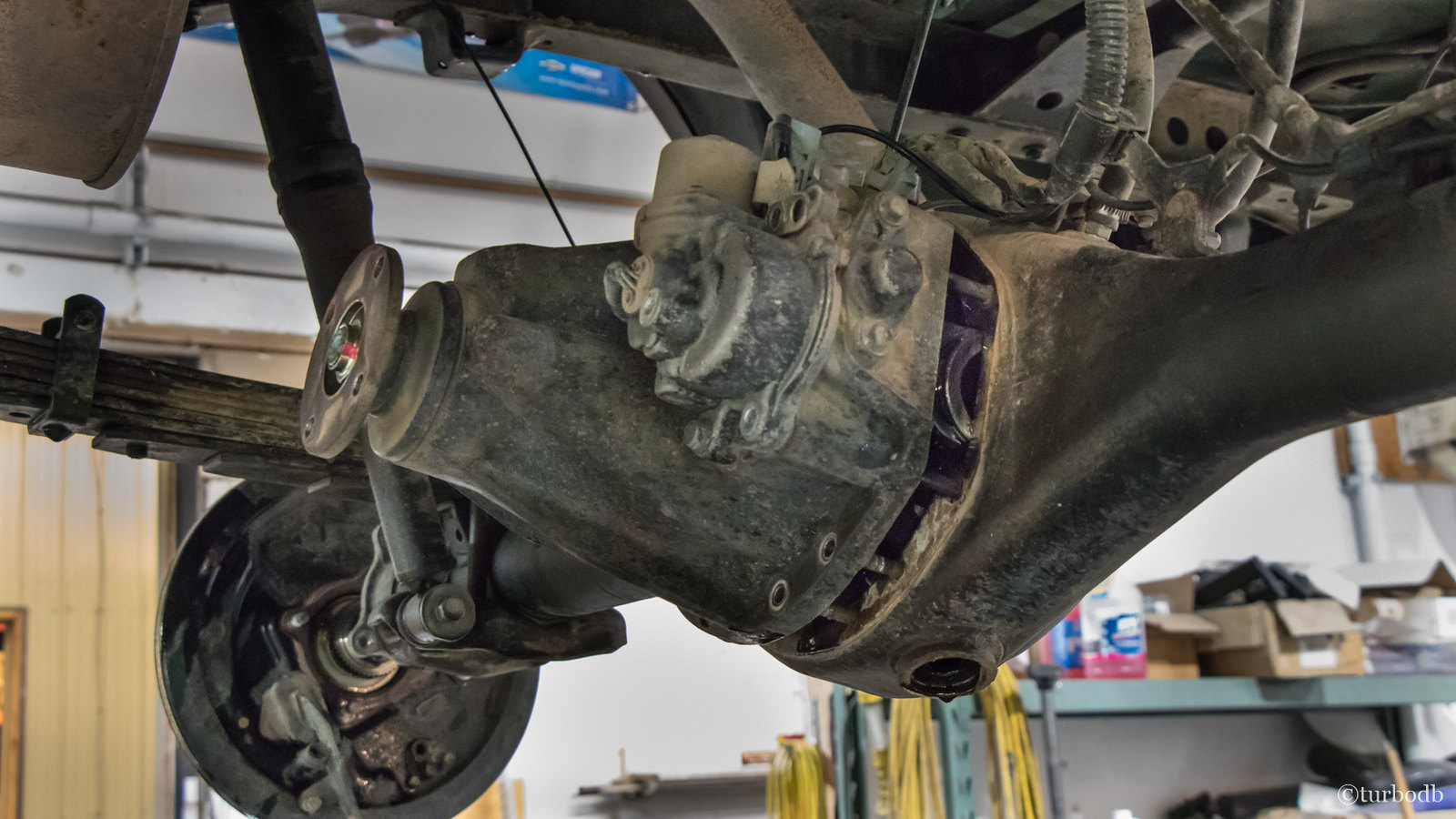

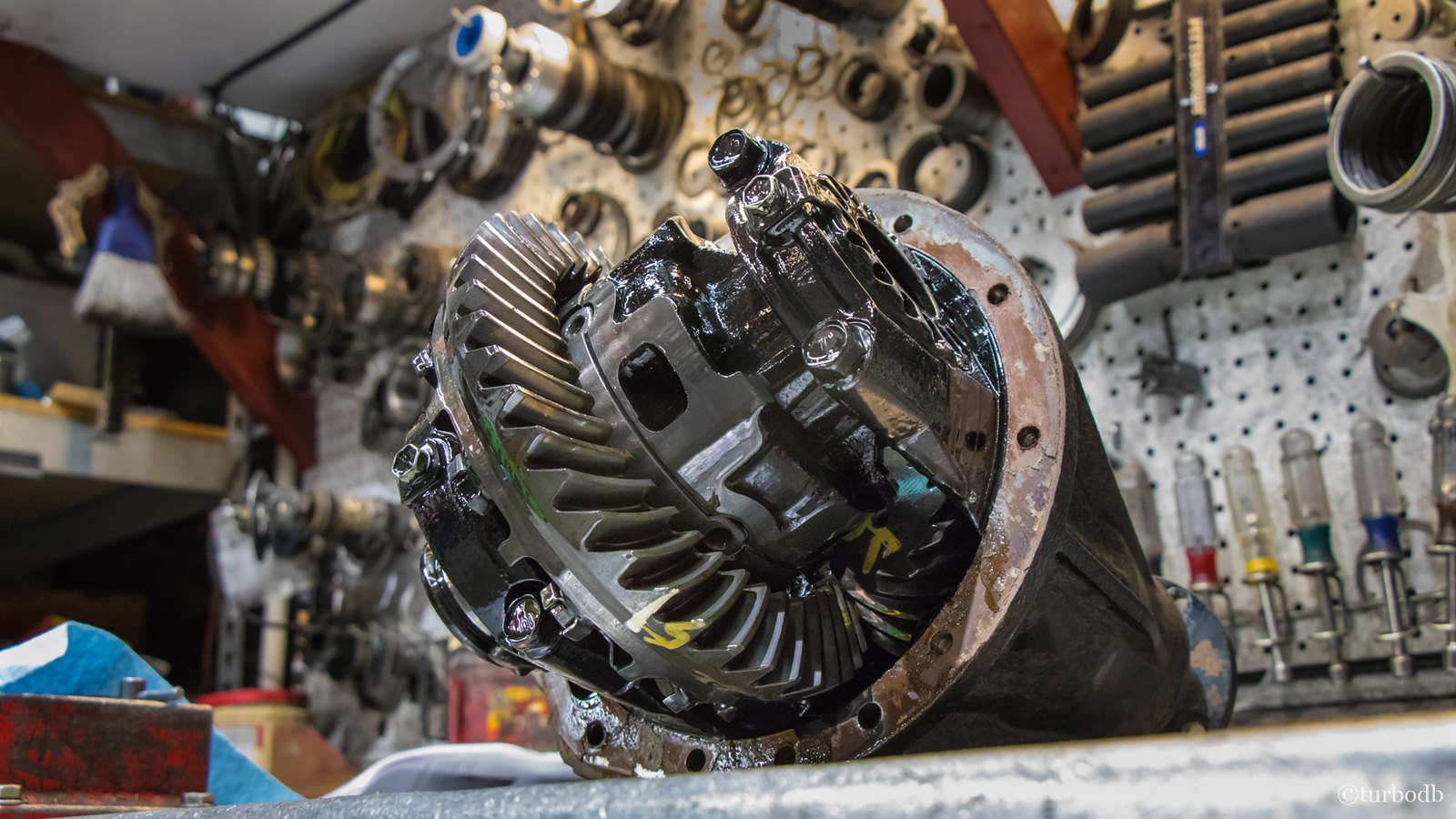
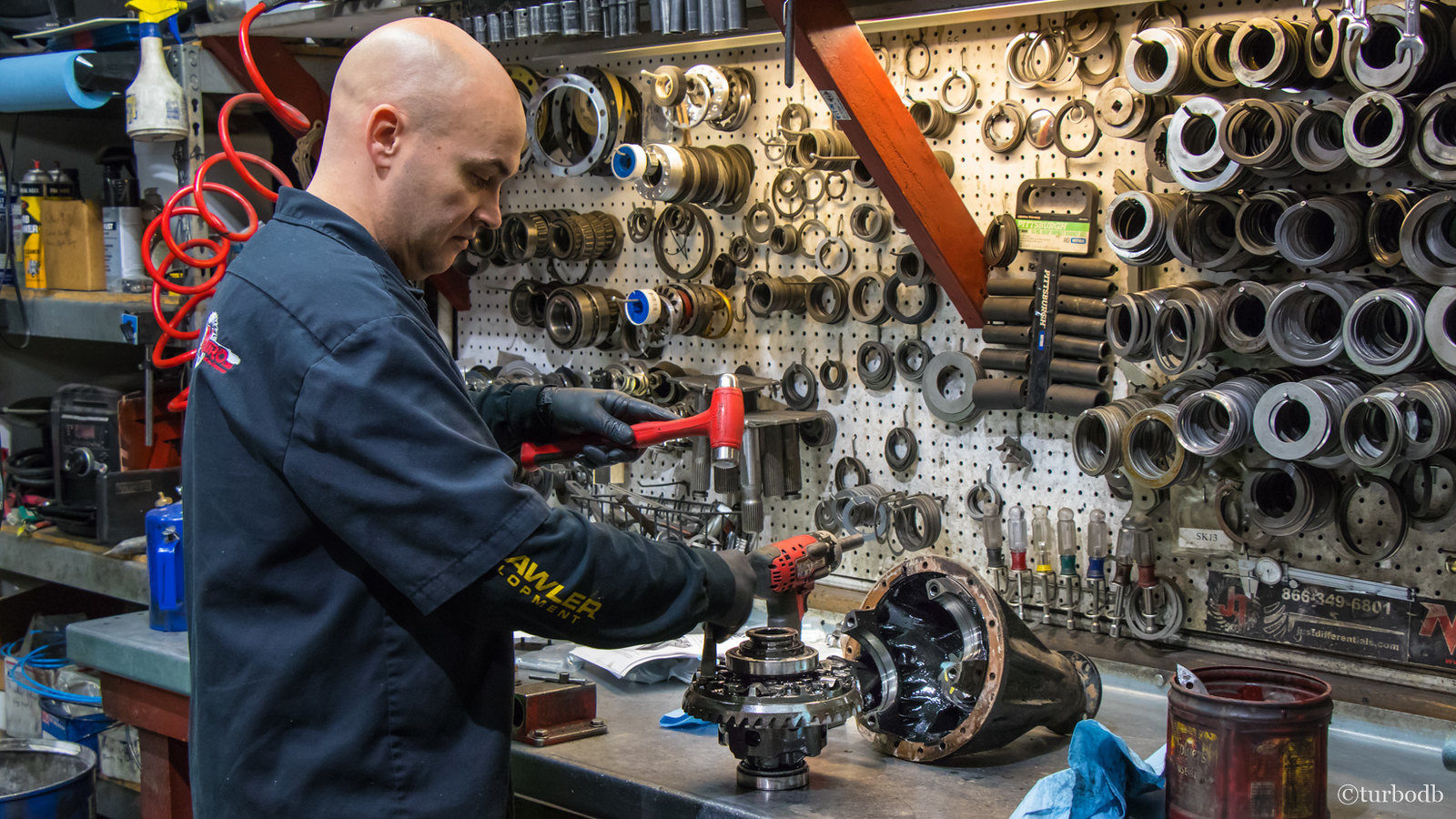
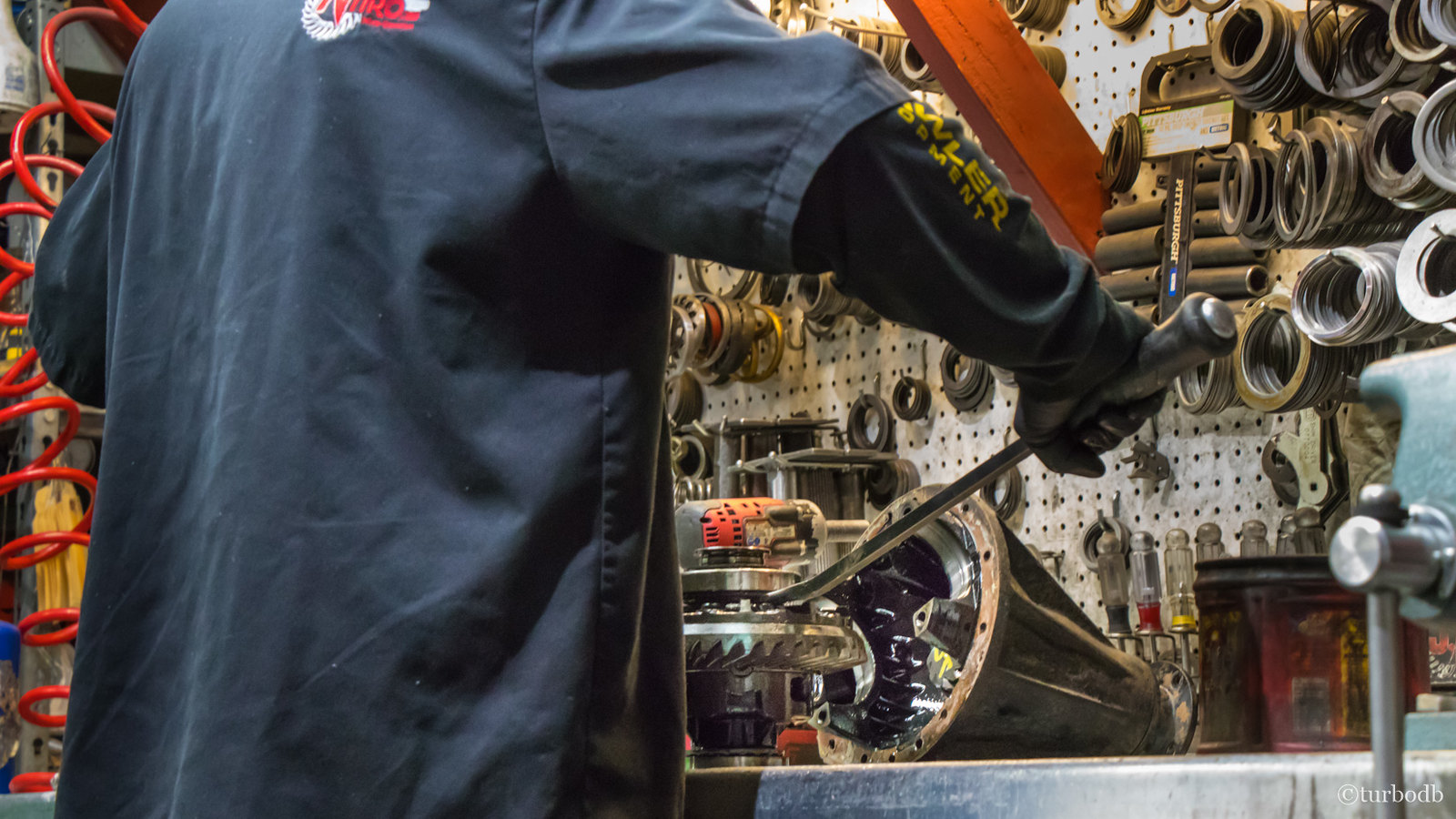
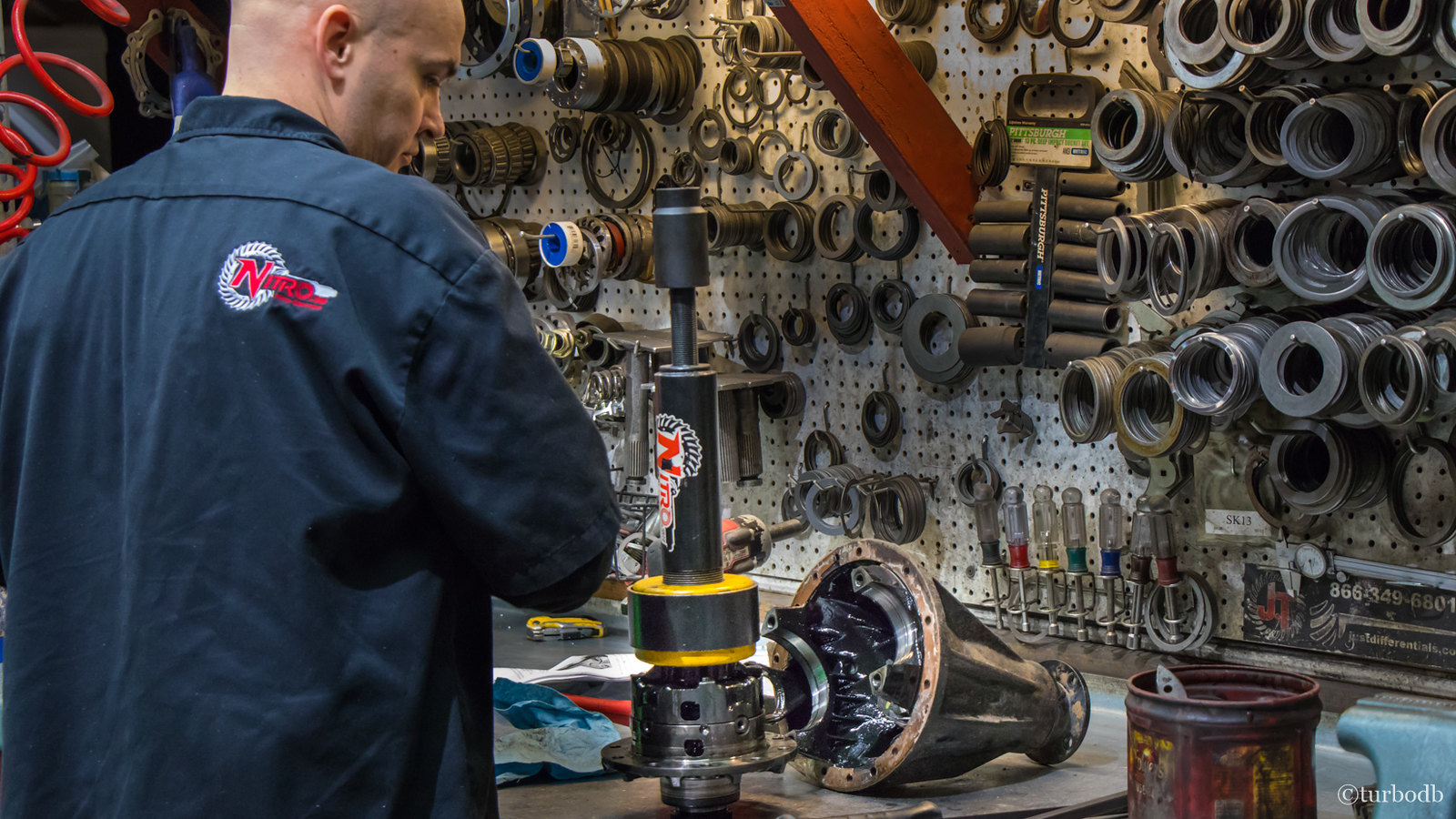
I was impressed by the fact that after each step, he'd lift up whatever part he'd been working on, and essentially clean up the entire bench surface. Through the entire procedure he kept the entire area very clean. Definitely something I liked seeing - that attention to detail indicated great things in my mind.
Everything disassembled, it was only mid-morning when they got to work on the final cleaning of the old parts - suffering most with the paper seal around the diff clamshell (which I'm sure had been in place for 17 years)!
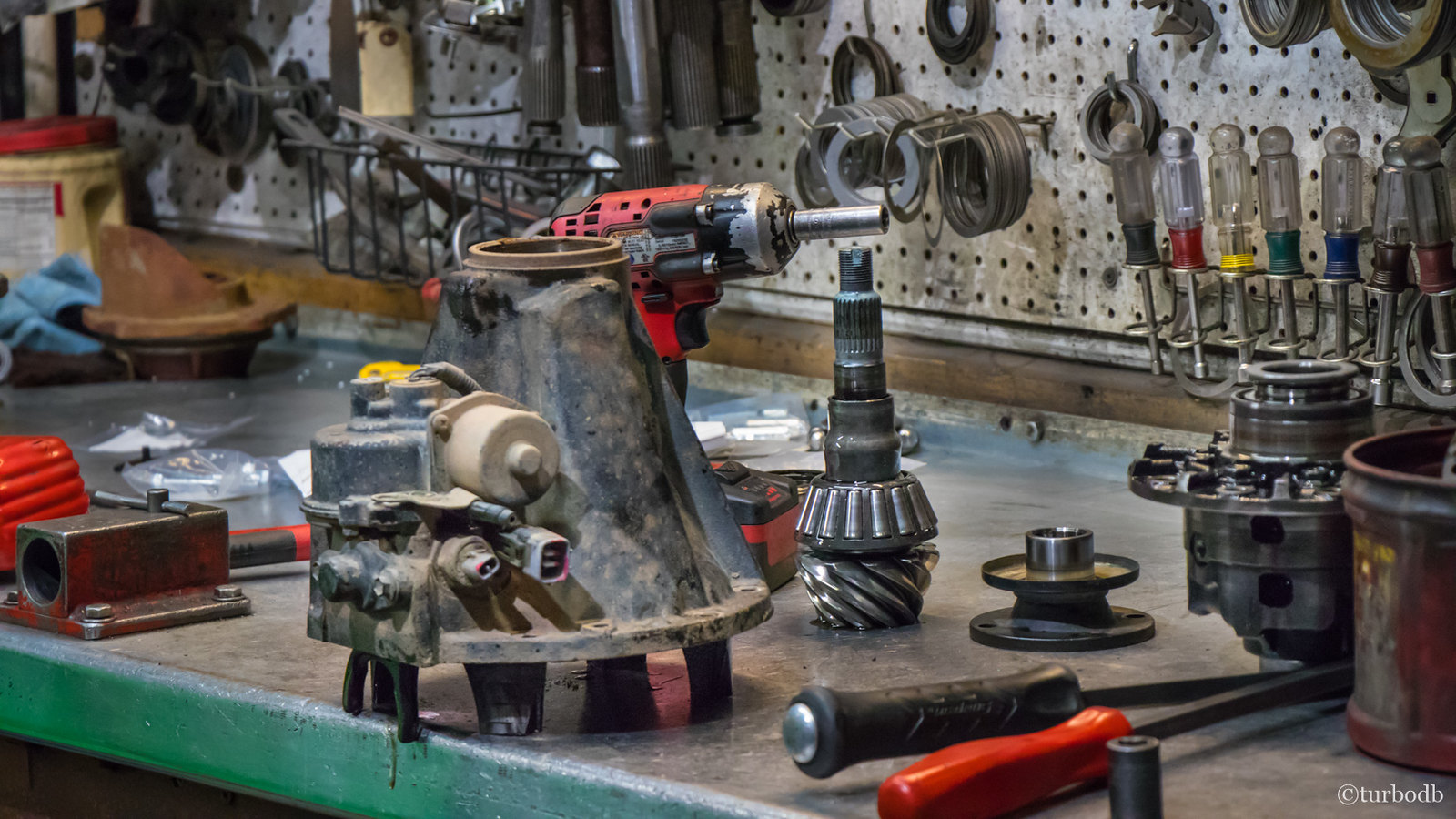
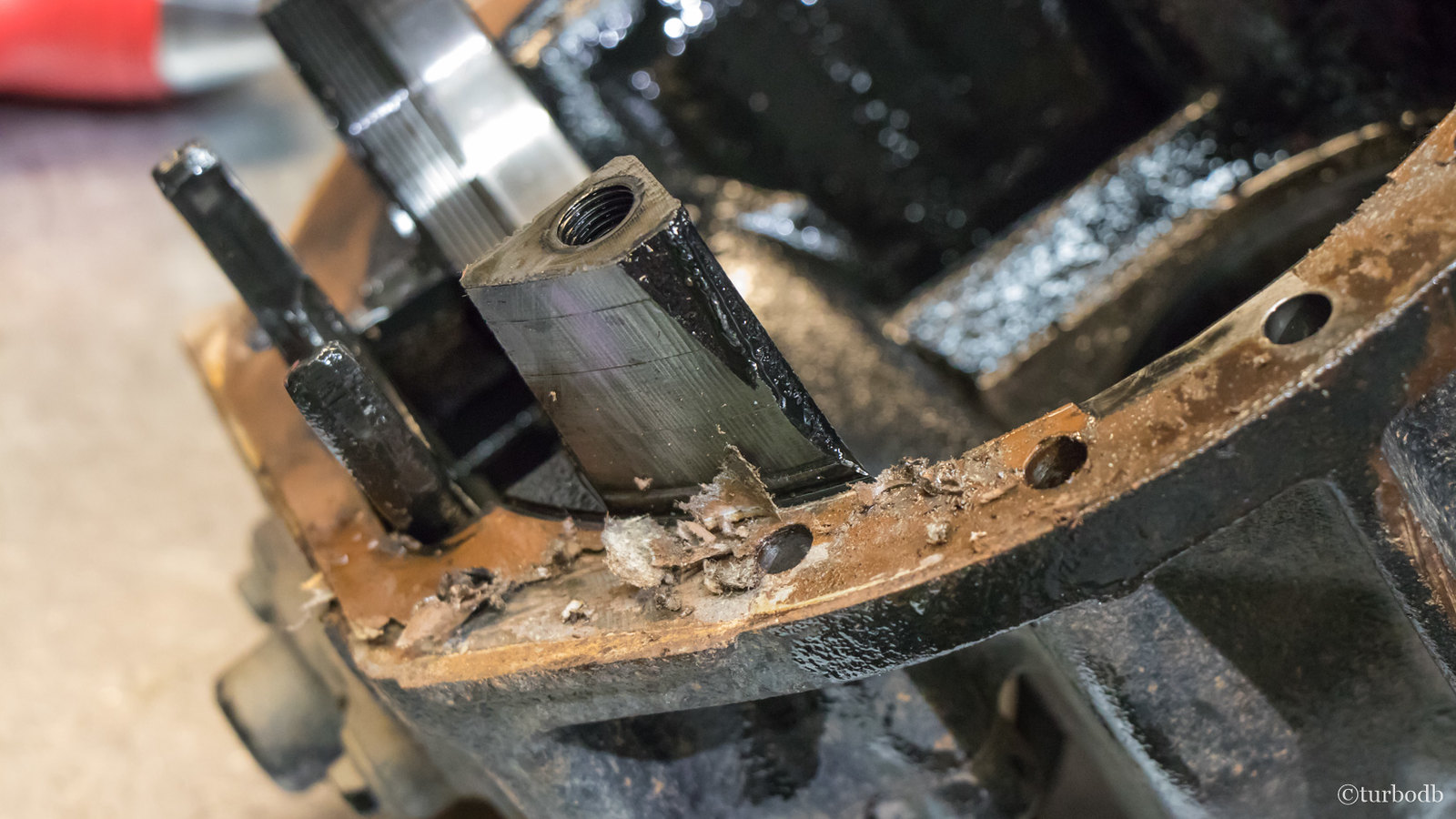

And then, it was time for assembly of the new rear diff. Boy, how I wish I'd been able to ask questions every few minutes of this process - because there were so many bearings that were pressed on, tolerances that were checked, and bolts that were torqued down to specific specs that I was once again glad that I hadn't tackled this myself (though, I'd never really considered assembling the internals) - it was clear that Jared and Chris were doing a better job than I'd have been able to do, and much faster since they had all the right tools!

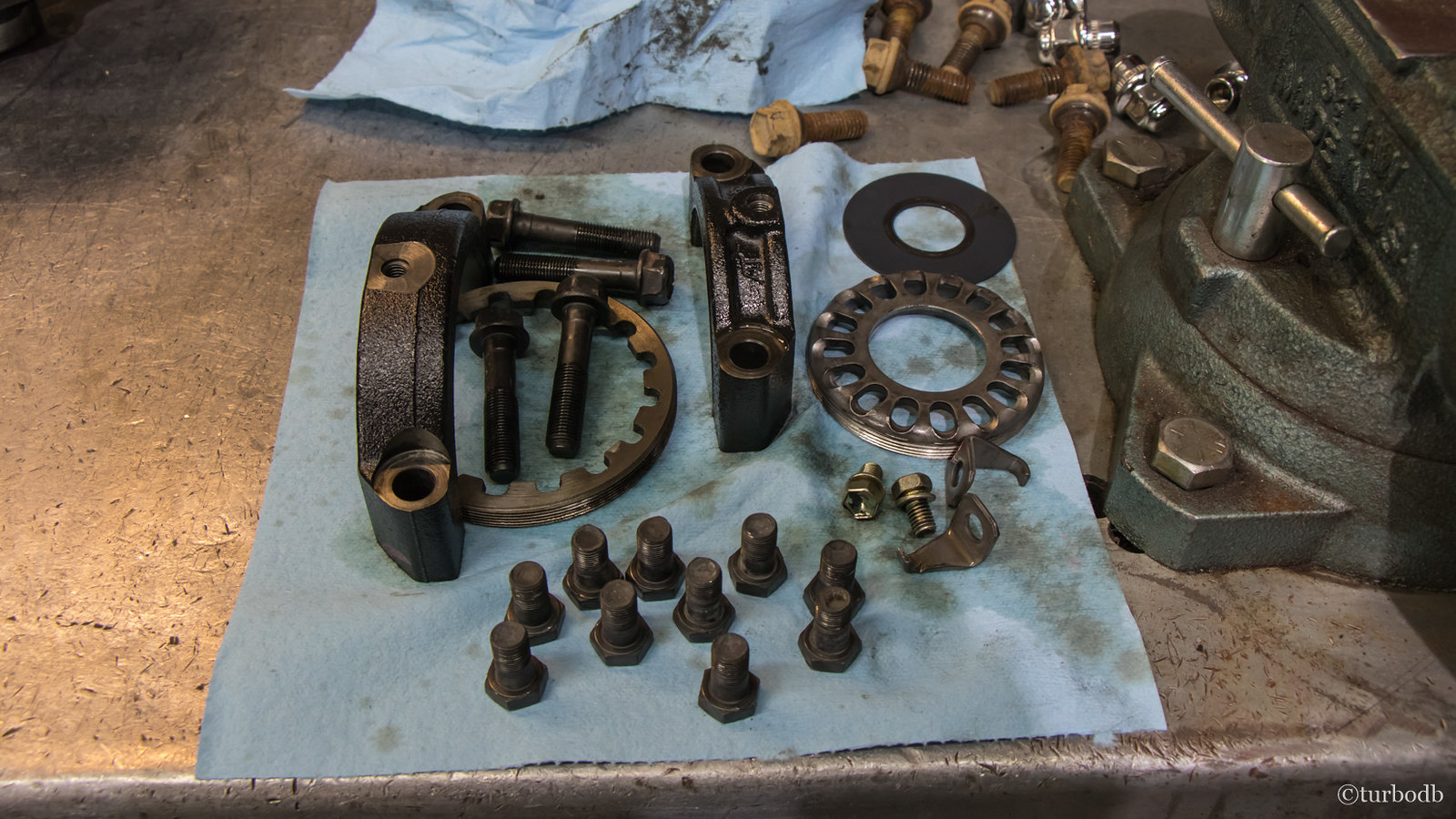

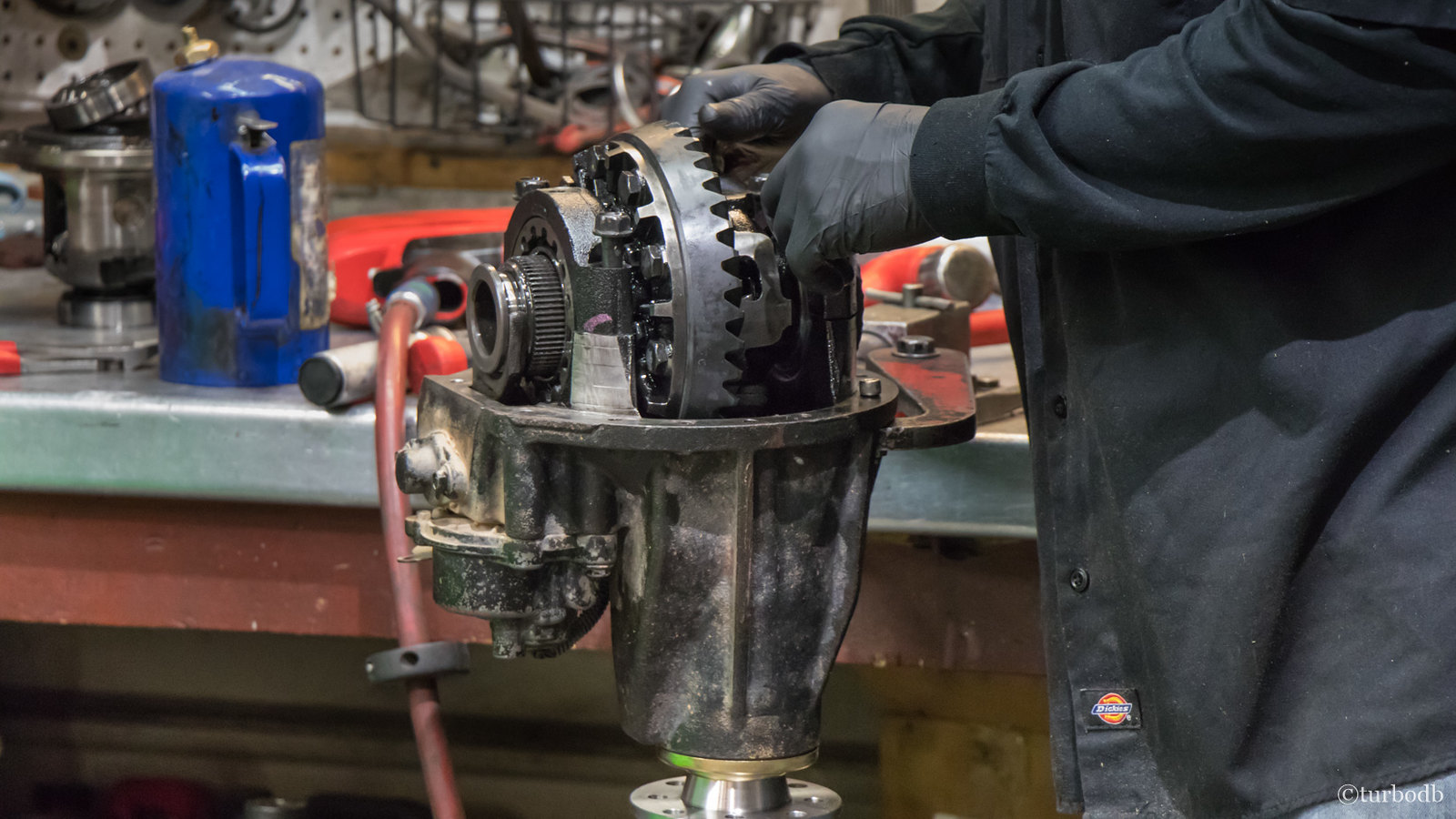
By 11 am, the new 4.88 rear gears were installed, and it was time to see if everything had gone together "just so," so out came the yellow paint and Jared cycled the gears a few times to see the wear pattern. After a couple minor adjustments, he was happy.
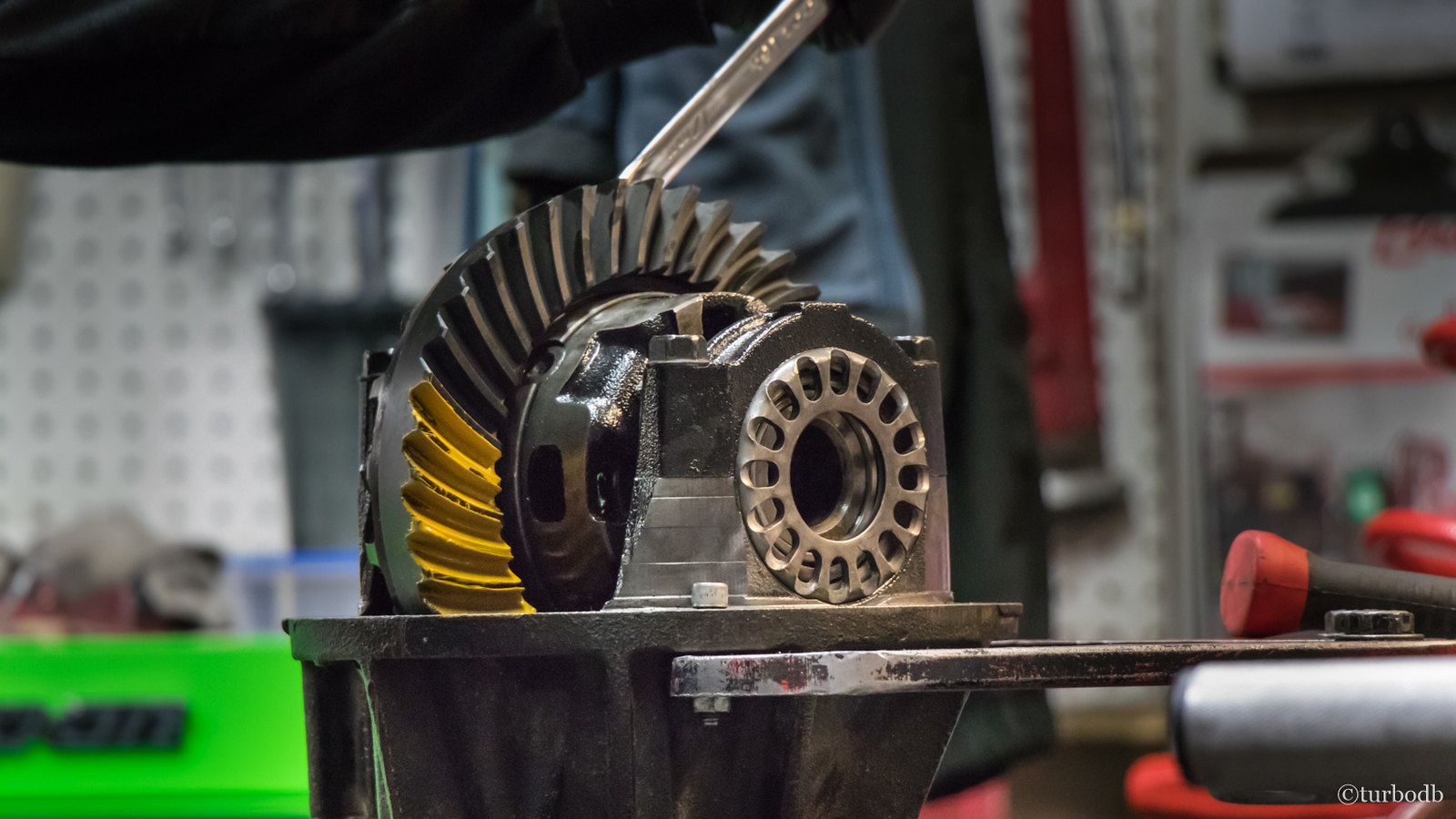
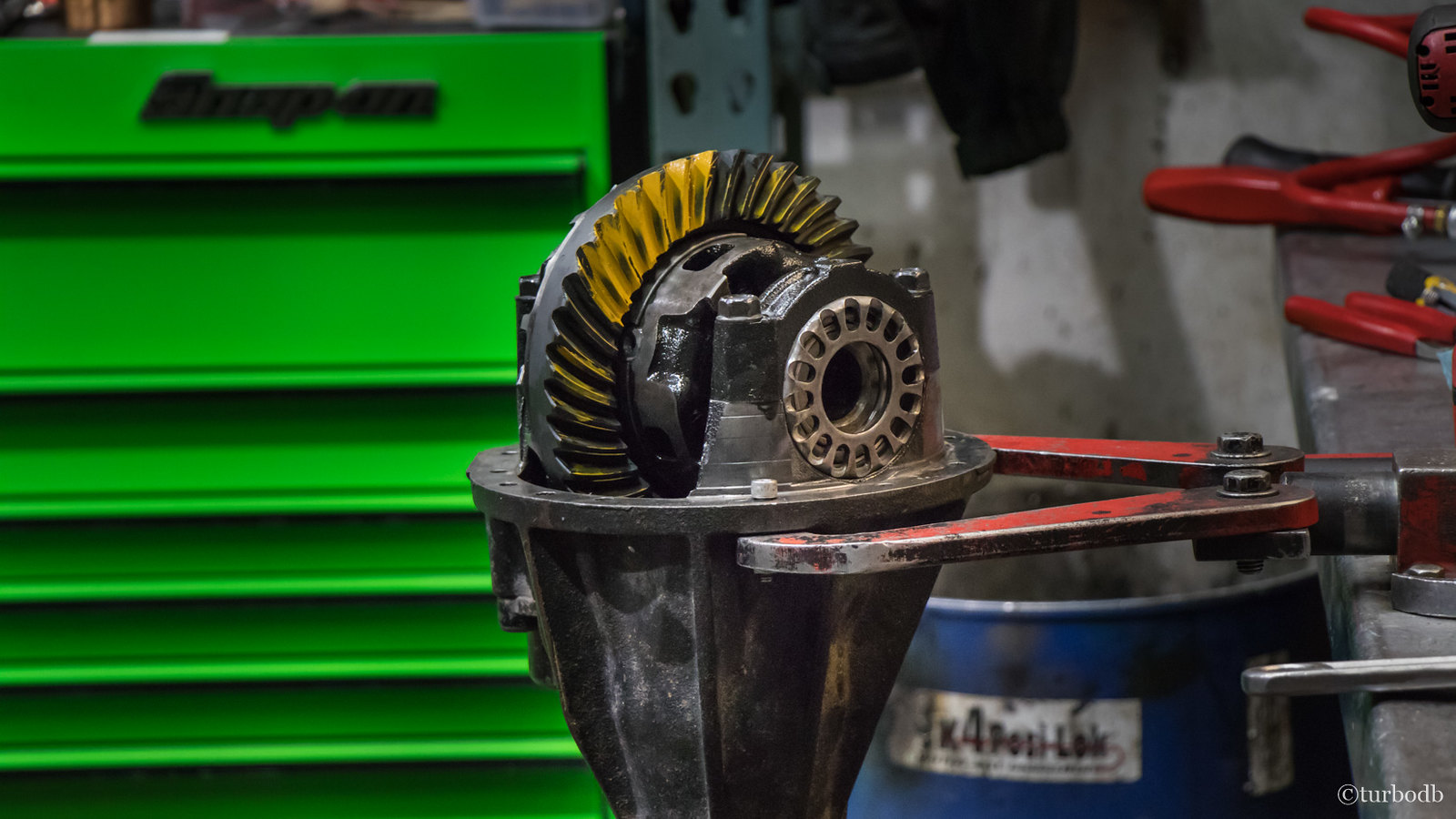
Chris had been getting the rear diff and axle housing cleaned up during this time, and had just laid down a bead of silicone as the new clamshell was read to be reinstalled. It went on without a hitch, and then they quickly got the rear end buttoned back up - except for throwing the wheels back on.
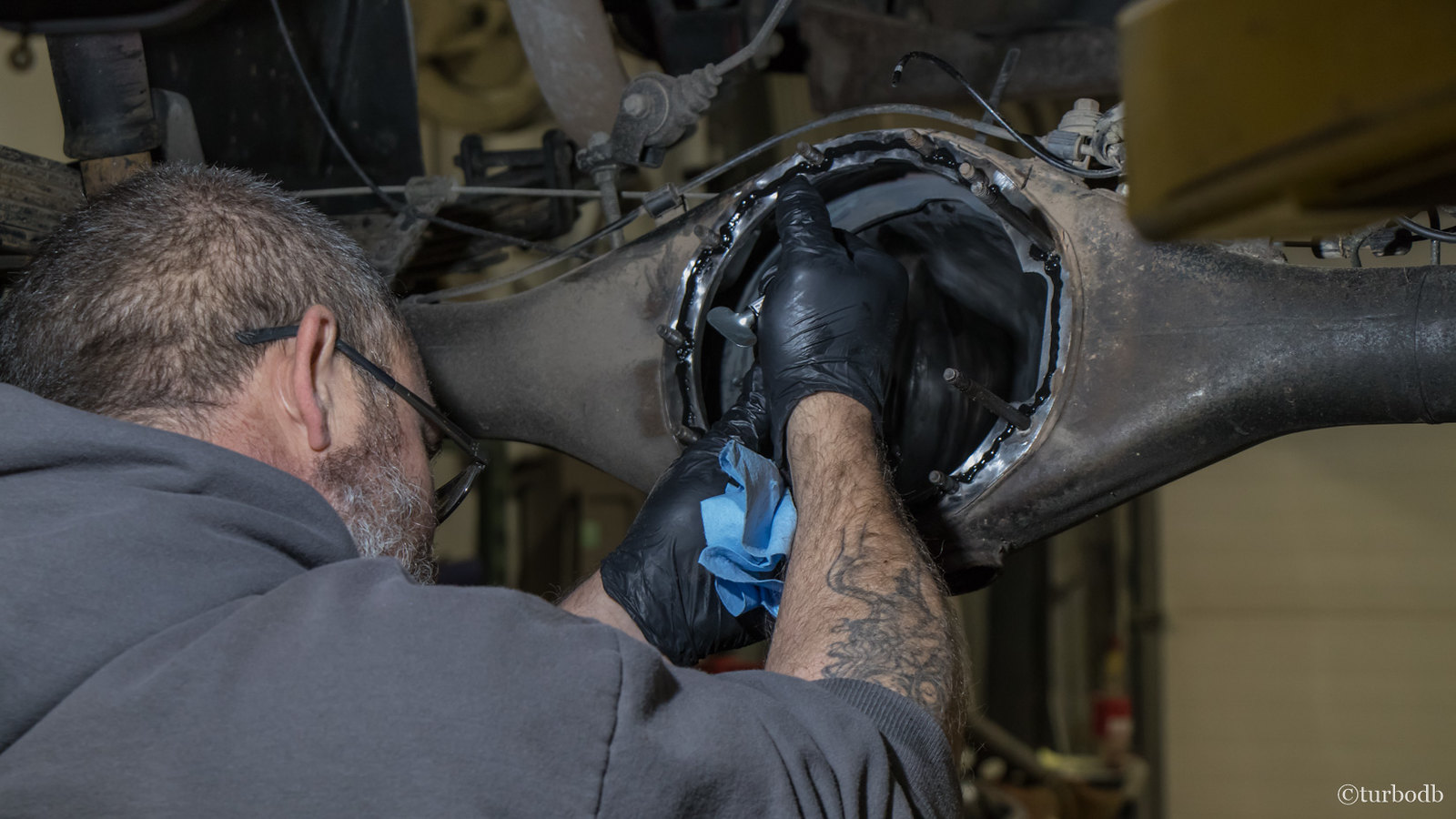
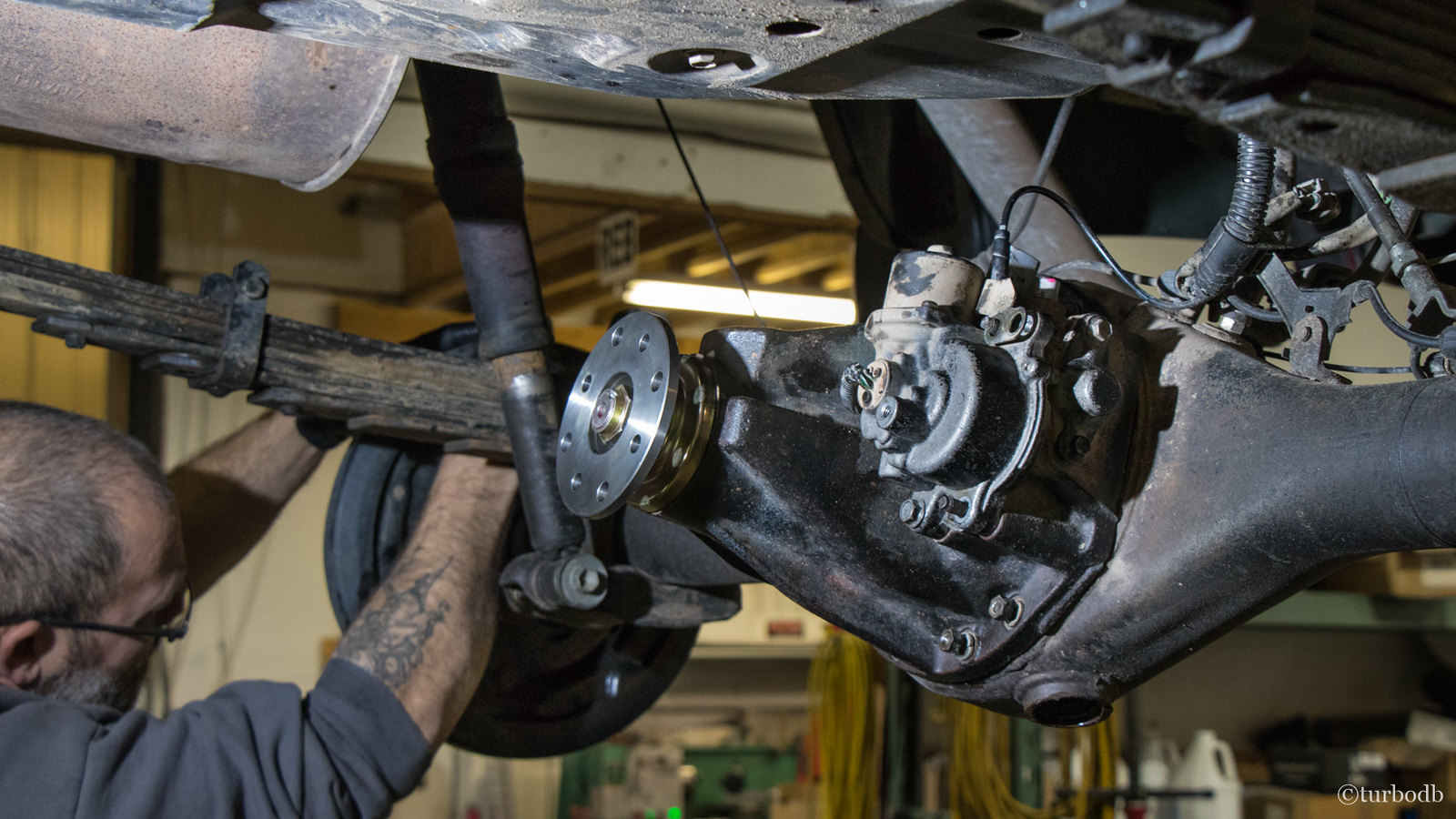
So, at 11:15am, they started on the front. There was a bit of armor to remove first - the @RelentlessFab skids were a hit, getting a few complements about beefiness - and then draining, hoses, clamps, and other miscellaneous bits to disconnect from the front diff before pulling it out.


Oh, and there were lower ball joints to remove. Pulling these made me think of all the lower ball joint issues I've heard of in the last few months. Definitely a part I'll be keeping a close eye on, especially now that they have been "mucked with."

Everything disconnected and out of the way, it was time to remove the diff, which can be a pain when the truck isn't up on the lift and there are two guys who do this for a living. For them, and in that situation, it pops right out, leaving a nice big "OMG something seems to be missing" hole under the truck.


The front diff was apart just as quickly as the rear had been, and by 11:45 am, I was cringing as Jared nonchalantly chucked up a step bit and drilled a hold in the diff cover. This of course was for the ARB air locker, but that didn't make it any less traumatic.

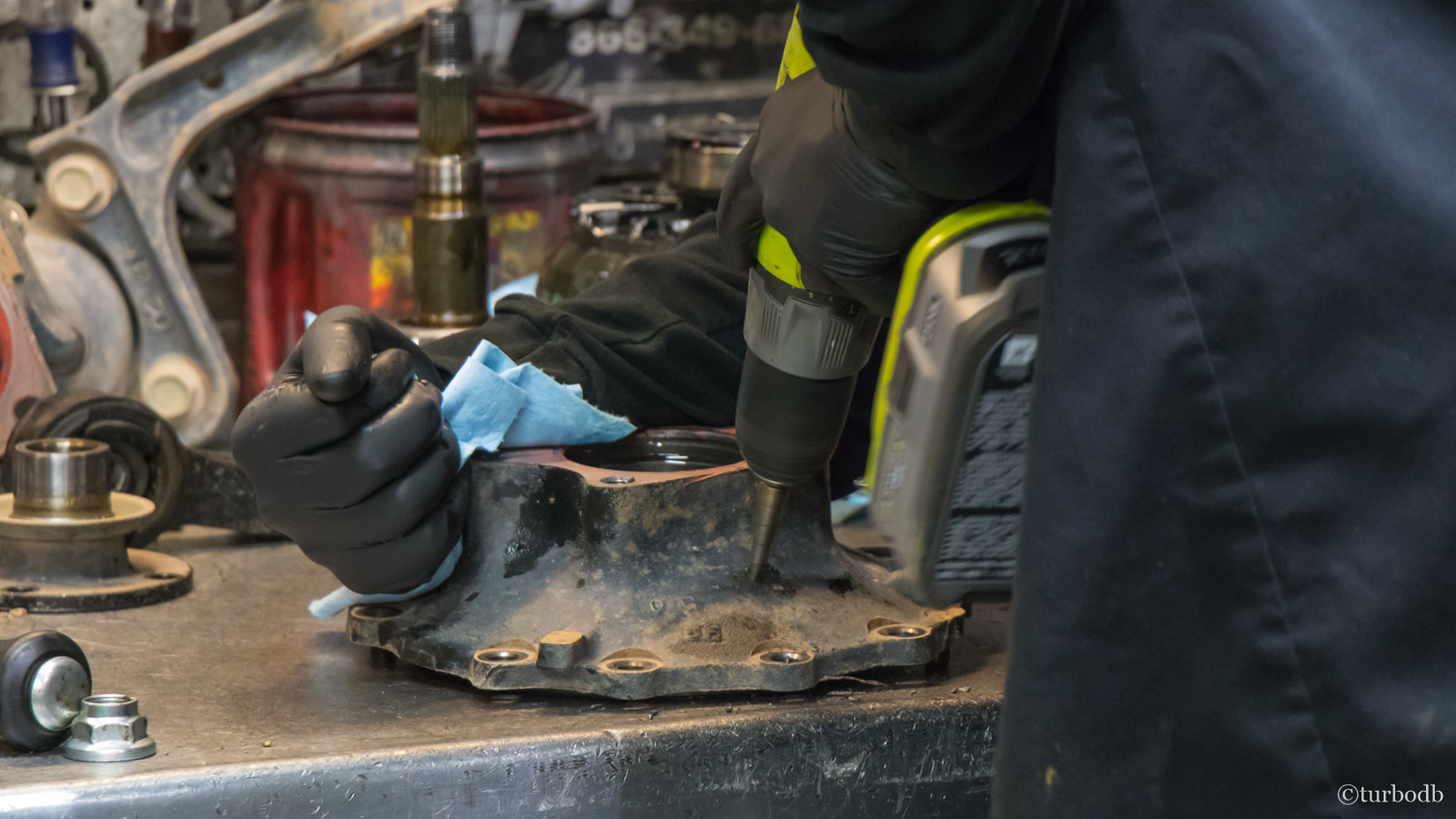
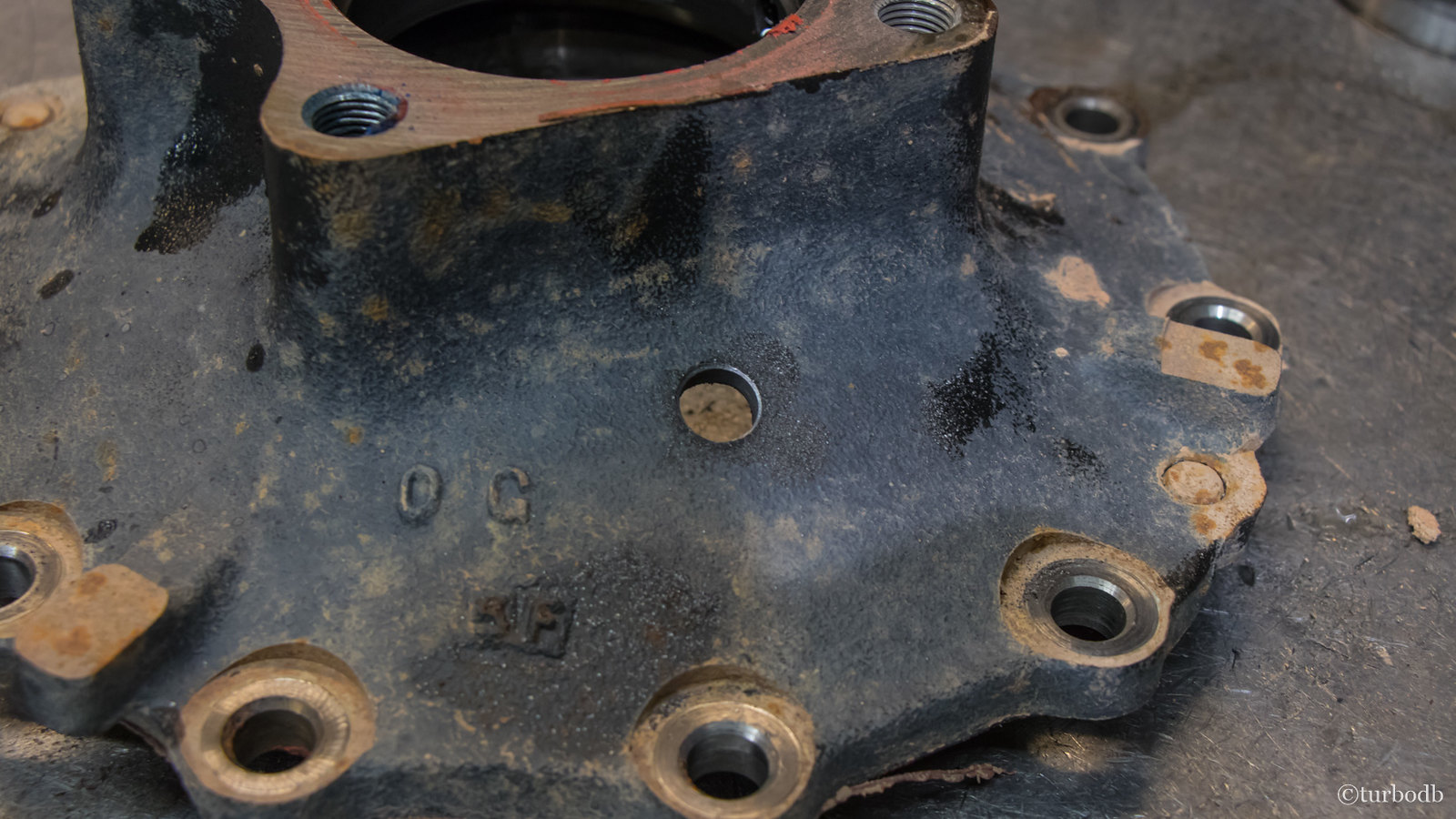
Working in tandem as they had all morning, Chris had been pressing bearings onto the new front diff/locker assembly as Jared disassembled the stock components. He then stepped in to tap the hole for the locker with the "nice new sharp tap" that they'd broken out of the box just a few days earlier.
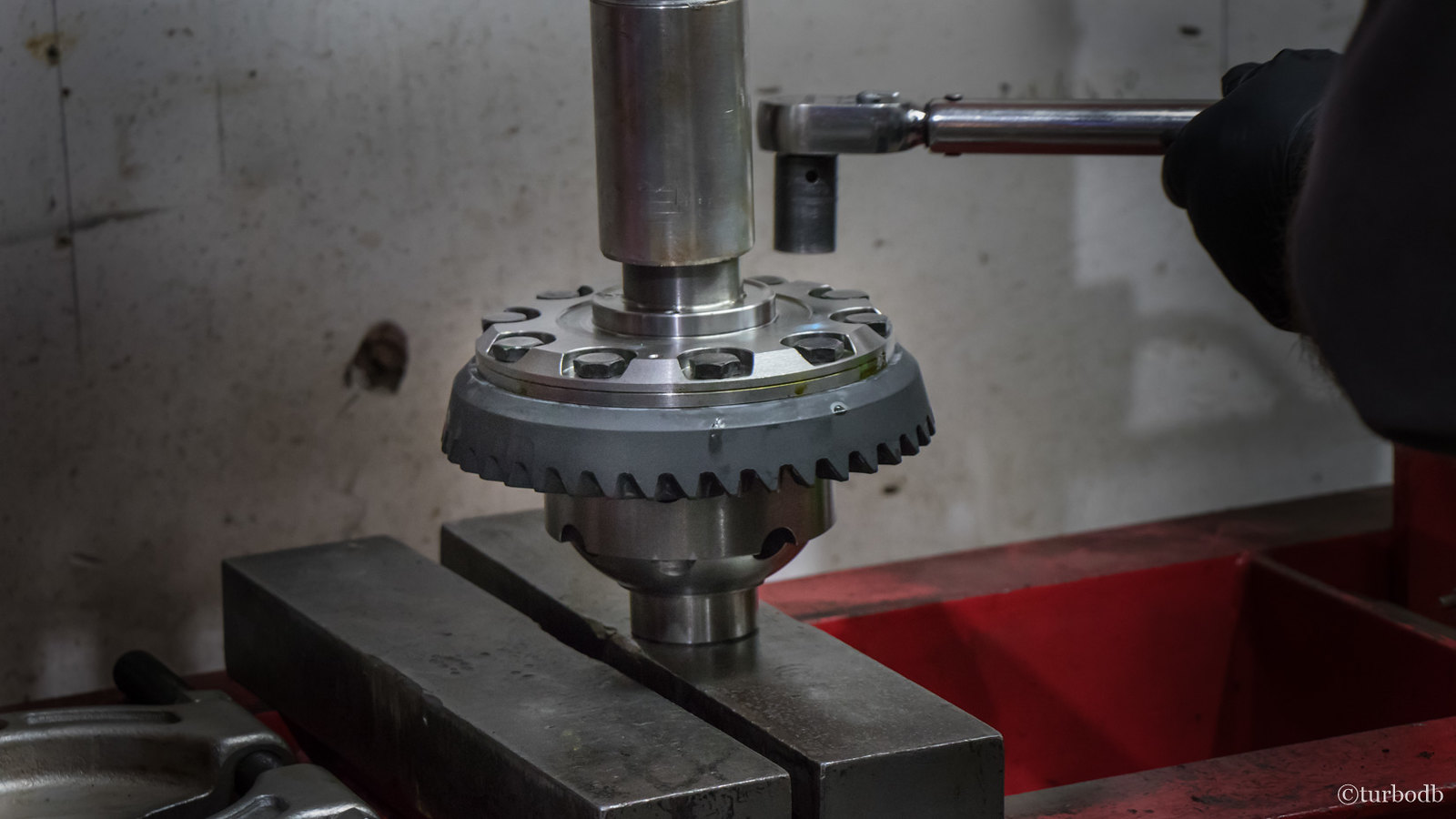
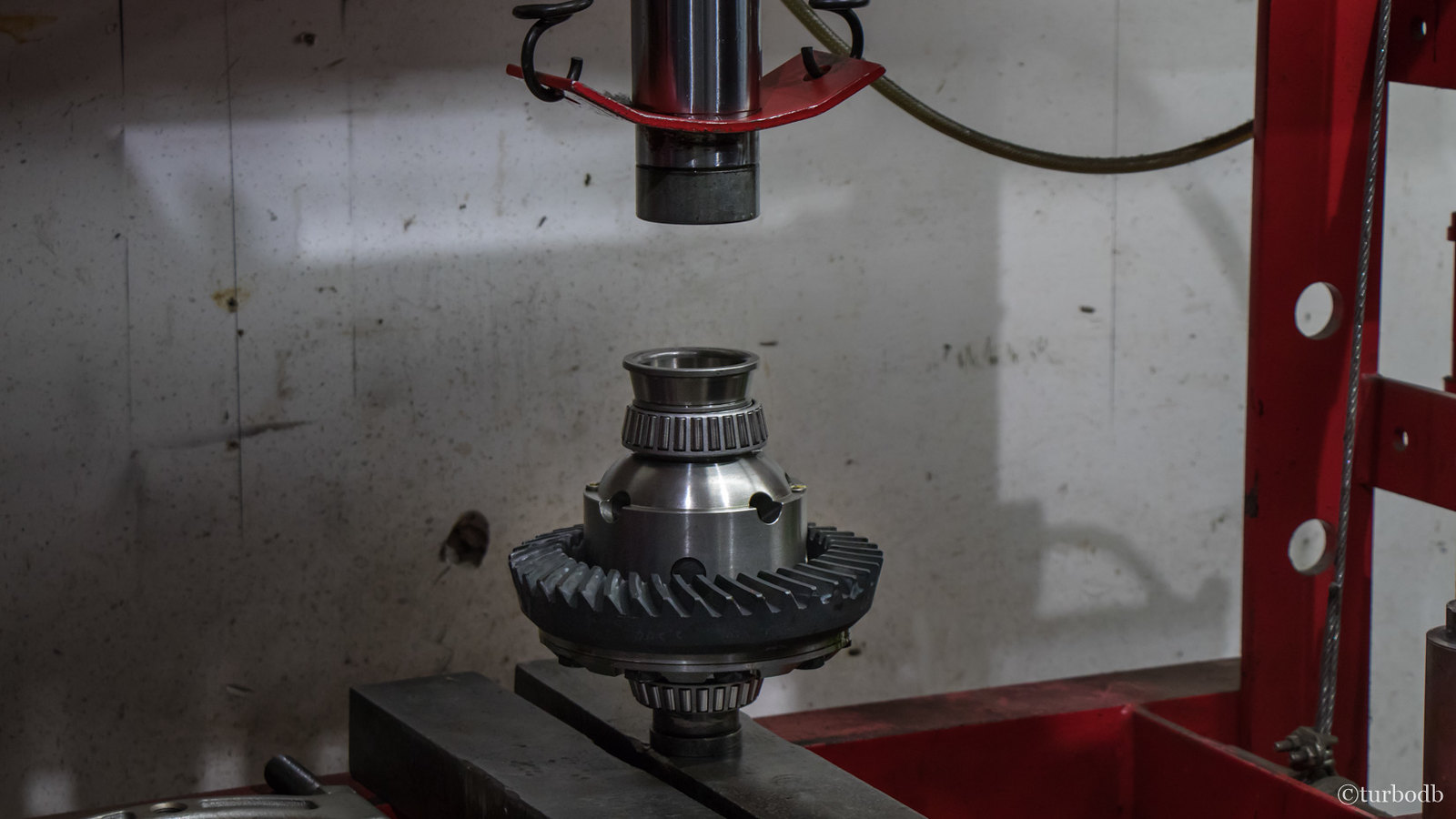

And then it was time to assemble and test the front - both for tolerances and wear pattern, as well as ensuring that it held pressure.
The pressure test went fine…


But the yellow paint and wear pattern wasn't perfect, and it was 12:15 pm - time to break for lunch! We all split up at that point to grab a bite to eat, and Jared made an off-the-cuff remark that he'd been hoping to finish by lunch…
Of course, I'd been prepared for two days, and I'm sure he could see the surprise on my face - because he said, "it'll probably be 3:00 pm now." When I mentioned the two-day estimate to him, Chris piped in to give me the low down - it seems that most "normal" customers don't show up on time, and usually there's a bunch of "extra" stuff that takes time - like installing the air compressor for the front locker, which often requires fabrication of a custom mounting bracket.
Well that rang true for me, having spent several hours fabbing up my own bracket for my Bussmann, and a day figuring out how to mount my ARB CKMA12 air compressor to the firewall. Plus all the time it takes to run wiring cleanly (which they also weren't going to need to do, since I was going to wire up the solenoid for the locker).
Of course, I was happy to get the truck back early. Unfortunately, the cost was still the same! 🙂
After lunch the final tolerances and contact patterns were quickly achieved, and the front diff was reassembled, hoisted back into place, and secured. Finally, the air lines were run up to the compressor using some "new, less flexible but probably better" hose supplied by ARB.
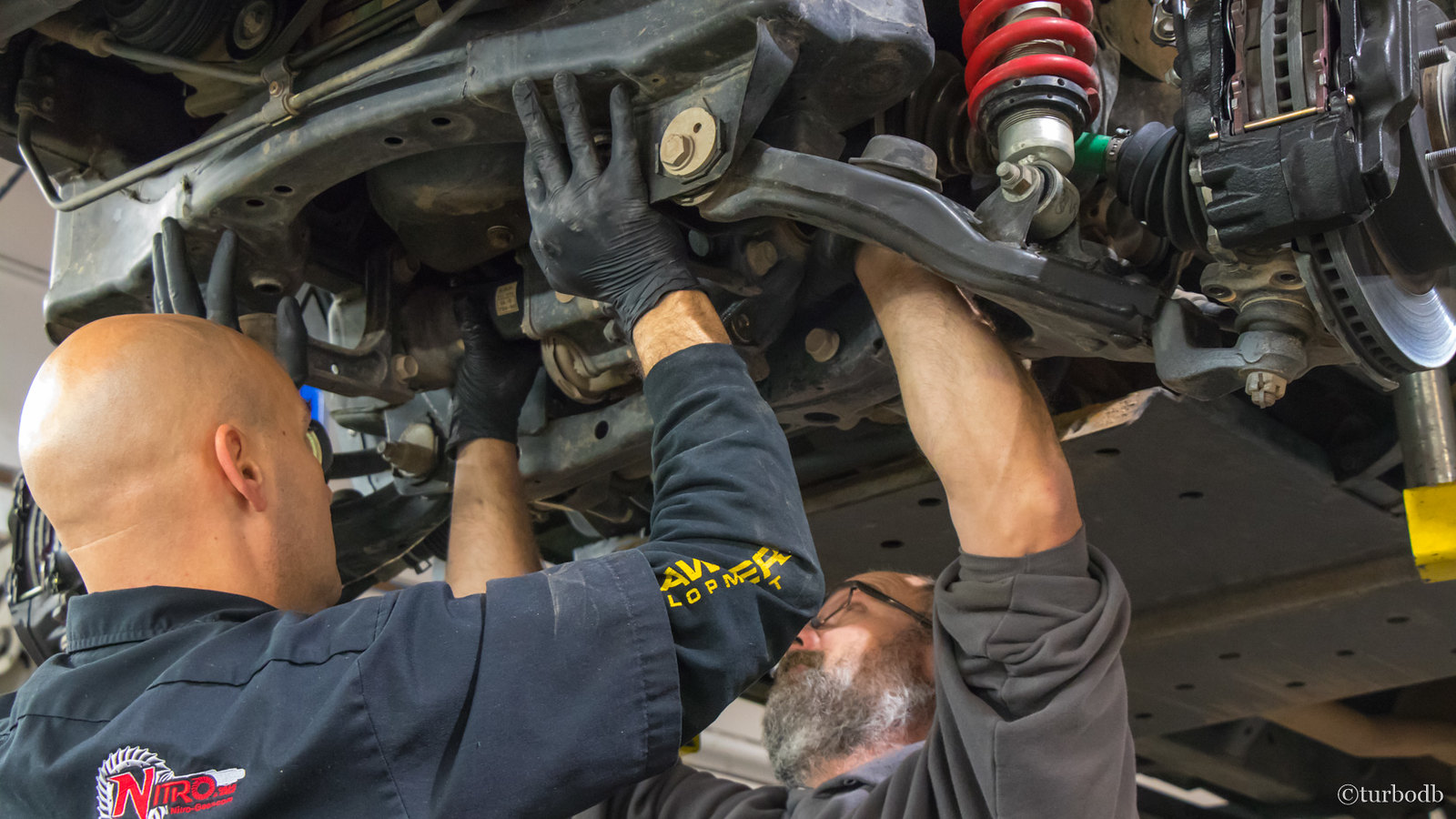
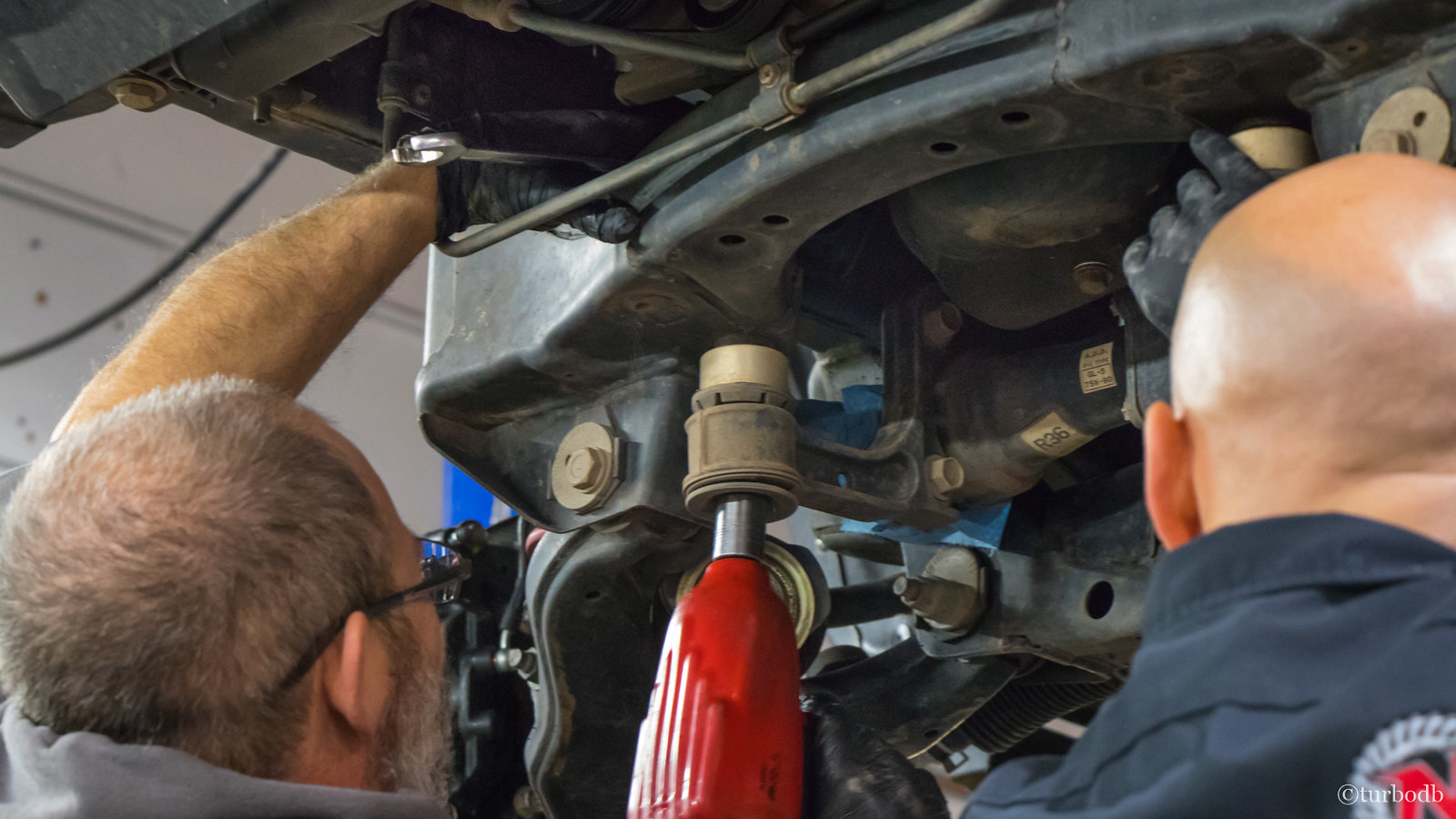
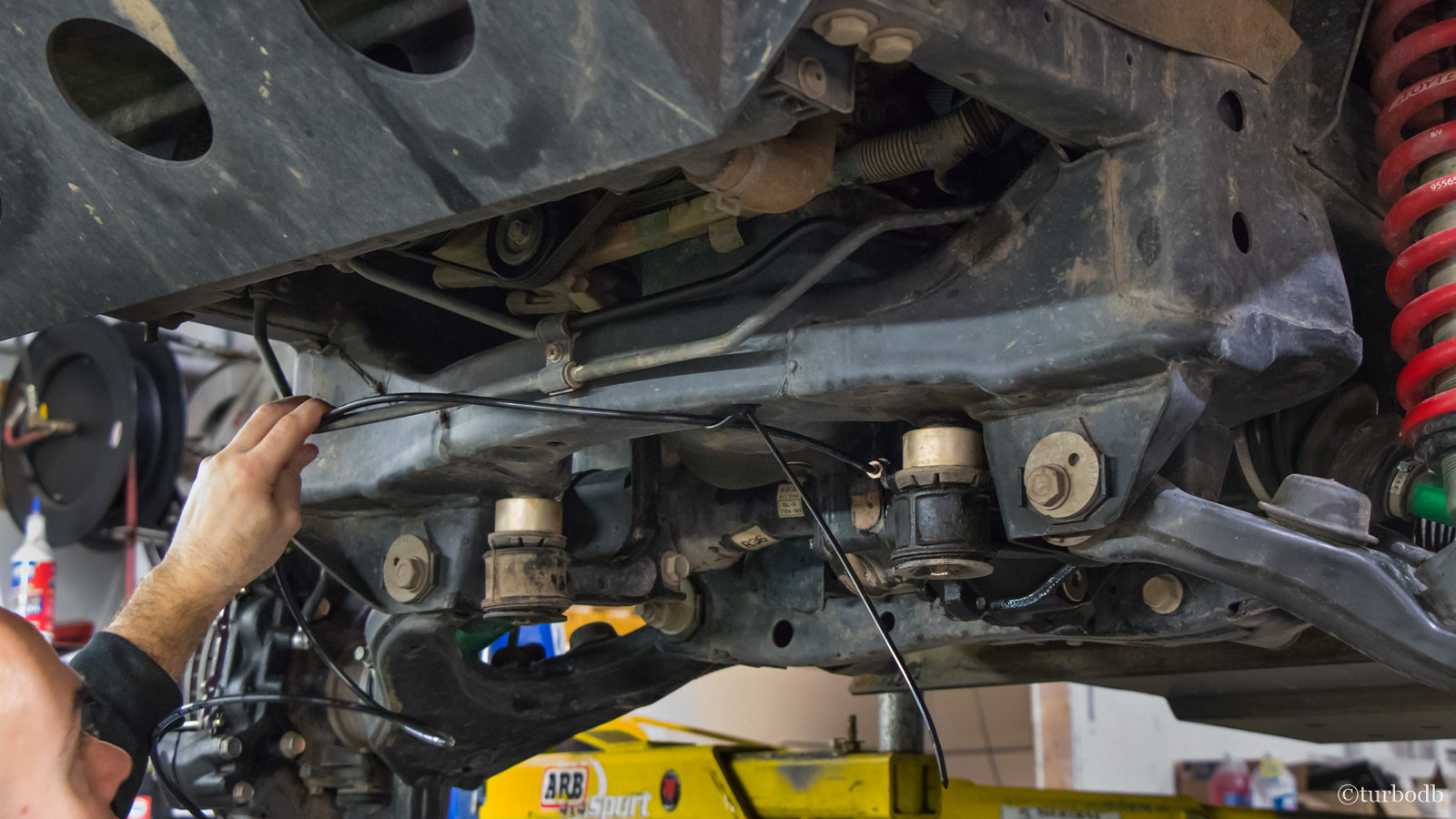
With that, and the reinstallation of the wheels, it was time for a test drive.
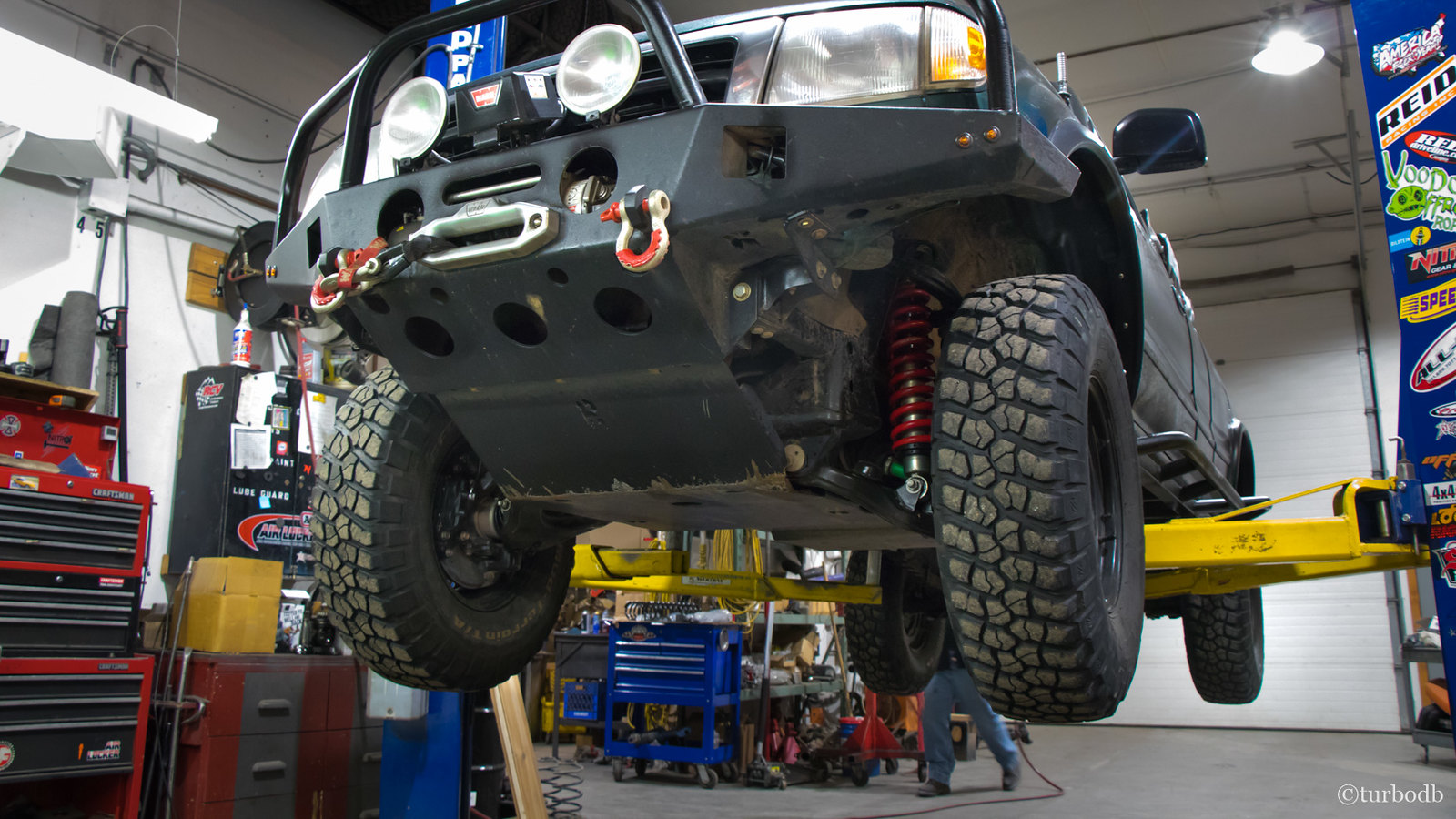
Now, normally the test drive is something that Jared or Chris would do, but given that I was there and obviously interested in the process, Jared offered to ride shotgun while I took it out on a 10-mile maiden voyage. Naturally, I was game, so we opened up the shop doors and headed out!
Not really knowing what to listen or feel for, I left analysis of the work to Jared. And he was happy - there was no significant whine to either differential (that we could hear), and while there was a little bit of drive-line shake, he assured me that it was well within the normal range, especially after increasing the gear ratio (thus making everything spin faster at a given speed). He didn't think I needed to do anything about it unless it bothered me - at which point I could start by getting my drive shaft balanced.
Right now, my tires being out of balance is much more annoying, so once I get that resolved I'll decide whether I can even notice the driveline vibration.
With that, instructions on break-in, a lightening of my wallet, and many thanks, we were done. It was 3:17pm.
Dang, those guys were good!
I was a happy camper - though I hadn't even really driven the new gears all that much to get a feel for them, I knew that the work done was quality work, and that made me feel great.
Little did I know just how happy I'd be once I had a chance to drive the truck a bit more and experience the awesomeness of the new gears…
In this Series

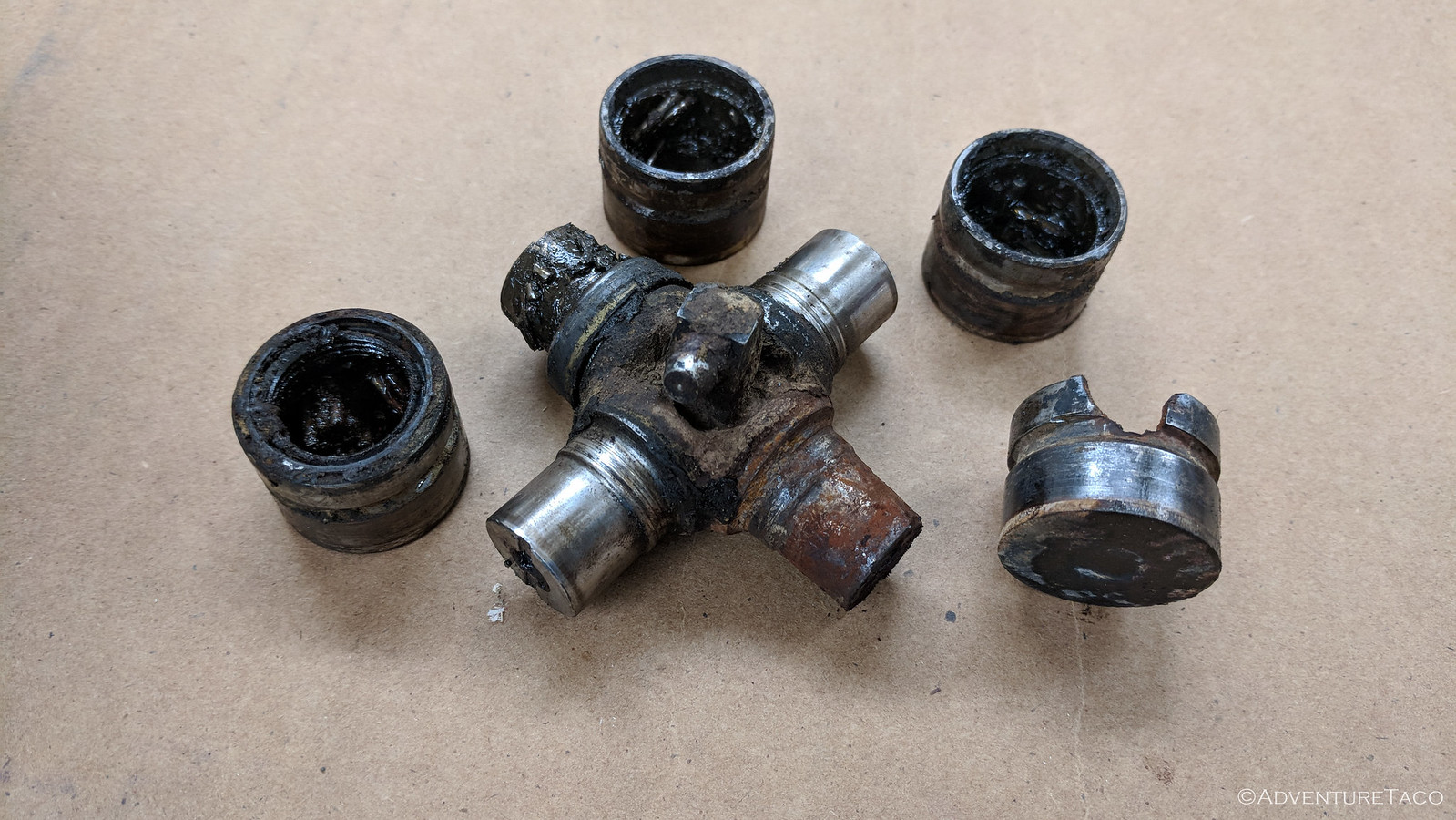
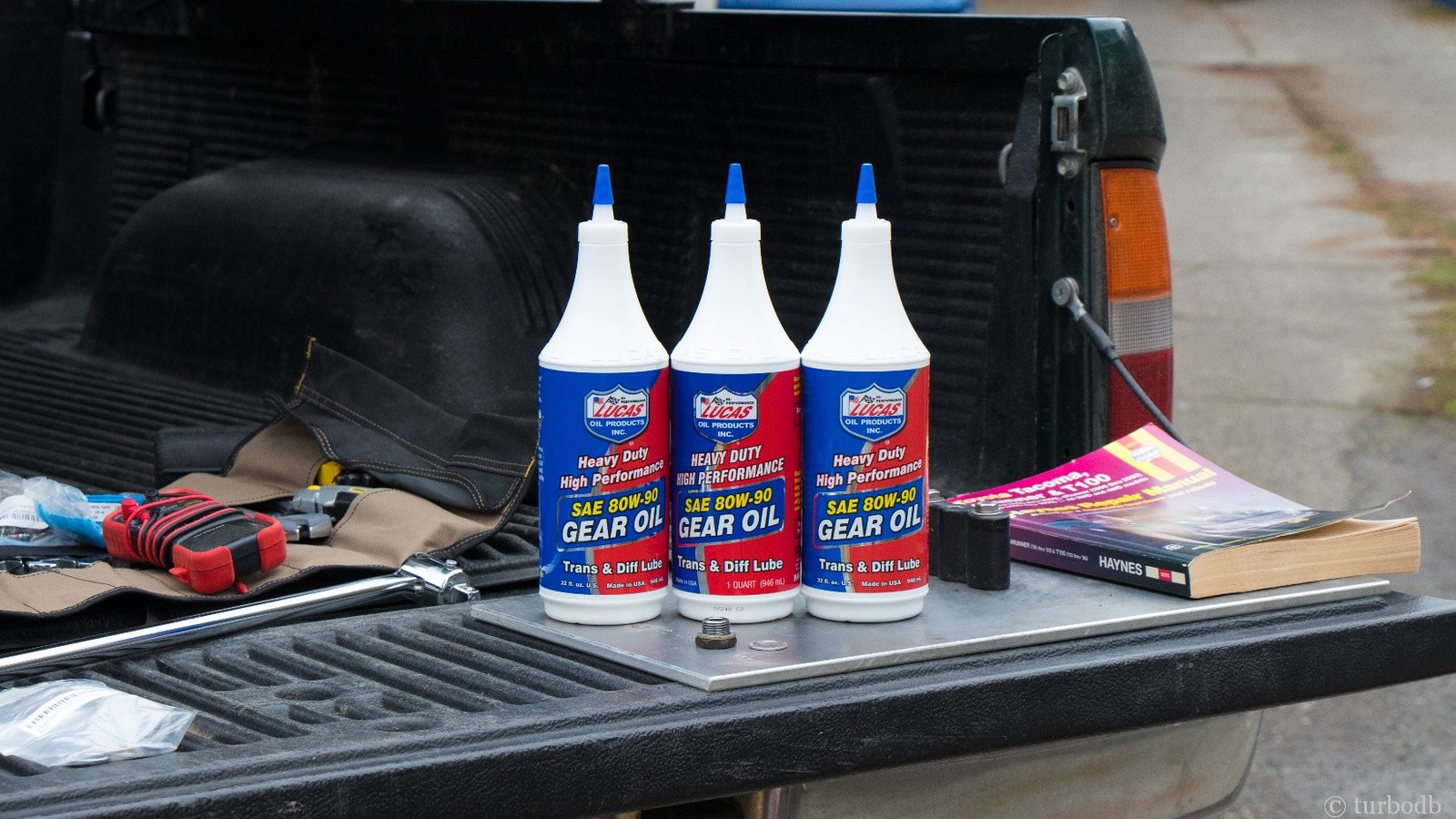
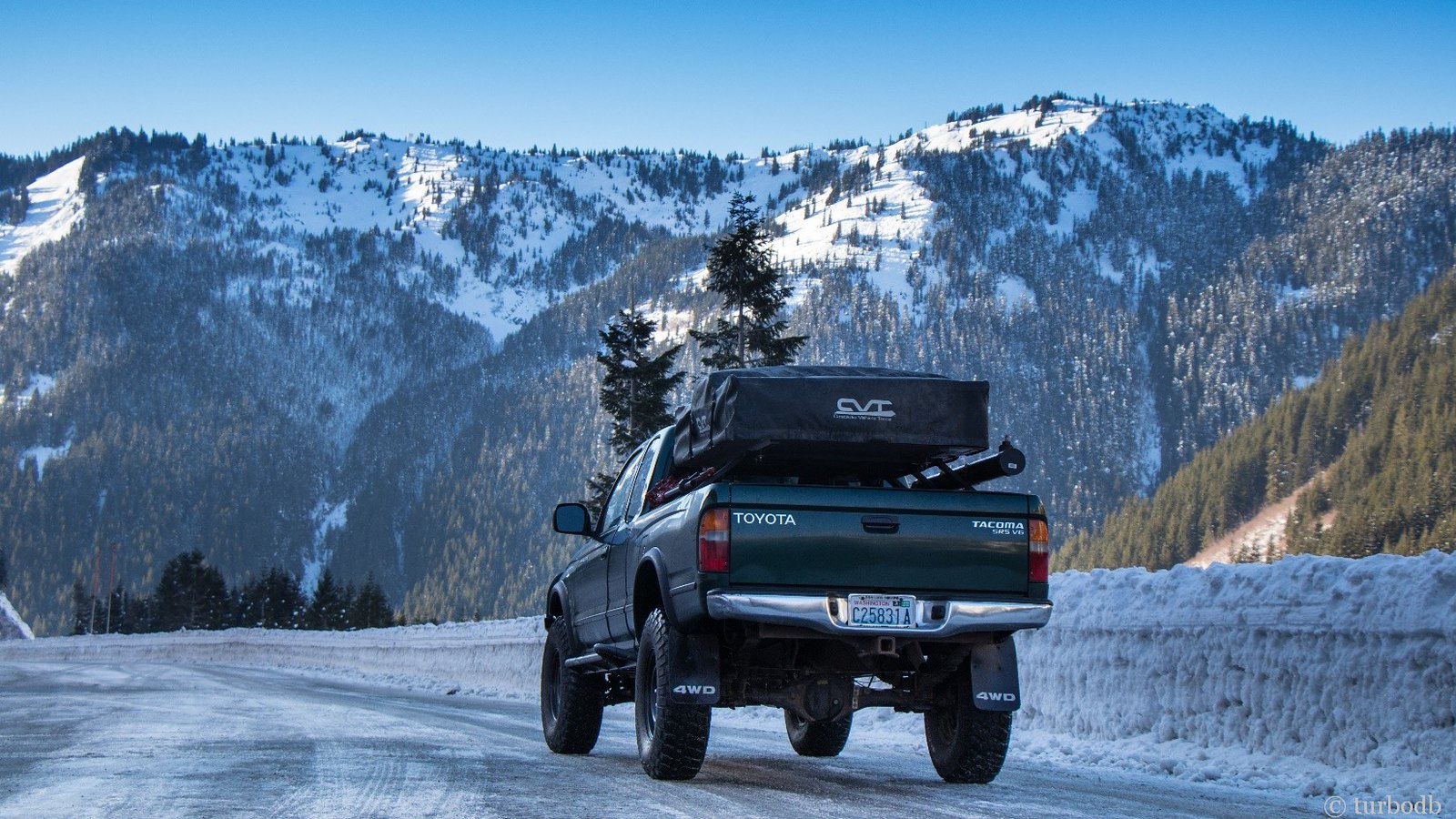

thanks for the great write up and pics - researching 3rd member swaps right now myself for my older Hilux Surf and a move to 4.88s for new 33s arriving, which I know will kill my performance...
This is great write up and those guys are indeed professionals that installed your new 4.88 gears and ARB front locker.
I currently have Pathfinder AT (Kumho) 265-75 R16 tiers on my Tacoma. They are a decent AT tire for SoCal but when it rains they slip a bit. I found a local a guy selling his almost new Bridgestone KO2s 235/85/16 tires from his 2020 Tacoma for a good price. I will get them installed in a few days and see how skinny tires perform on my 2002 Tacoma. My suspension is stock with Bilstein 4600 shocks that I installed 10 years ago.
I would like a better suspension for Overlanding but so many options out there that it gets confusing. I don't have a Toyota E-locker on my 2002 Tacoma SR5 4x4. I am not sure if I will need one and the trails I have been on were mostly easy.
How do you like the front ARB locker?
How are the 4.88 gears working out for you?
I read mixed reviews on ARB lockers. I know a few guys that rave about ARB lockers and others rave about TJM lockers.
Hi Brandon, I’m loving the 488 gears, and the ARB locker has worked well for me every time I’ve needed to use it.
One of the things I like about the locker is that it strengthens the front diff, which is good, since it can be a weak point in the front.
One thing I will say about 488 gears in a manual transmission is that it is very low gearing. It’s equivalent to having 529‘s in a auto. That is good on the trail, but makes highway driving at high speeds difficult, so I often find myself driving at 62 to 65 mph. That’s not ideal on a long trip but doesn’t bother me too much as I’m not in a huge rush.
Did you notice an improvement in MPG after the 4.88s?
I'm trying to decide between 4.56 or 4.88 on my 2004 Tacoma. It's an A/T 4x4 on 285/75r16 KO2s. I've heard 4.88s are great for the trails and 4.56s are better for the highway, but 80% of my driving will be to GET to the trails, haha.
Hey Reggie, The 4.88's didn't improve MPGs at all - in fact, on the highway, they decrease MPGs since I'm running at a higher RPM (ore fuel) for the same speed. In fact, at 62 MPH, I'm running right around 2750 RPM with 255/85R16 tires (33's).
Now, I have a MT, so I'm already geared a bit lower than you will be with an AT. One of my buddies has an AT on 4.88's (and 285/75R16 tires - also 33's), and he's consistently about 500RPM lower than me at highway cruising speeds. So, with an AT, you'll be running at about 72MPH @ 2600-2700 RPM.
Essentially, you can think of it sort of like this: MT+410s is equivalent to AT+4.30s, MT+4.56s is equivalent to AT+4.88s, and MT+4.88s is equivalent to AT+5.29s. So, if I were you, I'd go for the 4.88s - I think on an AT, they give you good balance for onroad and ontrail.
One of my buddies has an A/T with 4.88's, and he
Thanks for the reply. I'll probably go with 4.88s
Are you still able to use your ARB compressor to air up your tires?
Yep, the ARB compressor still works great to air up the tires!
I’m running 255/85-16 BFG KM3’s on my truck and for the most part am very happy even with stock gearing. I know you changed your gears to 4.88’s. Long term are you still happy?
Thanks! Steve
Hey Steve,
Not a bother at all - ask questions any time! (I might be slow to reply sometimes when I'm on the trail, but I'll always get to the questions when I get back).
I'm still really liking my 4.88s. I think a big part of the reason for that is how I use the truck now, which is to say that it's not a daily driver, and so I prefer that it be more "geared" towards (lol) trail conditions rather than road conditions. Out on the trail, there are lots of places where I really like the ability to put the truck in first gear and just let it idle through rough terrain, rather than having to feather the clutch in order to navigate obstacles at the correct speed.
The place where I don't love the gears is on the highway. There, I find that I'm at about 2700RPM when I'm going 62mph, and that 2700RPM is about where my engine is happiest from a MPG perspective. As such, I find myself travelling to/from dirt more slowly than I might otherwise (I'd probably be in the 70 range if I still had my stock gearing).
I should also probably note that a lot of my perceptions are due to the fact that I have a manual transmission. With an auto, RPMs at a given speed are about 500RPM lower than a manual, and the transmission helps to "cover up" a lot of the variances with gears. As such, while it might be tough on the transmission, either stock gears or 4.88s can get you through the same terrain, because you don’t have to worry about manual clutching. And, with the lower RPMs on the highway, even with the 4.88 gearing, you can still travel at higher speeds.
Anyway, not sure if you have a MT or AT, but those are my thoughts. For me, it's been a great mod, and one I'd do again.
Cheers,
Dan
Hey man, im Re-Gearing my 1999 Tacoma and saw that you’ve already done that and you added a ARB locker.
Im debating getting a locker and was wondering if you found yourself using it very much? And if you have been using it, are you worried about breaking CV axles? I wheel my truck and like to try technical trails but I usually take it fairly easy on the throttle.
Hey Bendan, my recommendation is to get one while you're in there, for three reasons:
I don't use my lockers all that often, and I'd say I've used the front probably only a couple dozen times in ~5 years of having it. However, what I really like about it is that it's "instant on." So, I can get into a sticky situation, where only the front wheels have good traction (going up a ledge or whatever), and I can pressurize the front locker and almost immediately climb up the obstacle. No rolling around to get it to engage like an elocker, etc. (though, I do like my OEM rear elocker too)
I've never had any issue breaking CVs, but I'm pretty careful with how I use the front locker - it's usually only on for a few seconds to climb an obstacle, and then I switch it off again. I never do any significant turning with it on (esp on something like slickrock). I think if you're cognizant of how you are using it, you've got relatively little to worry about with CVs.
If you could do it over again, would you go with 4.56 gears to get you on a better highway rpm but sacrifice that little bit of lower gearing for off-road? I’m also a MT 5speed on 3.4L 4runner with 285/75/16s (32.8”)
Hey J, if I were doing it again, I'd do it the same way. As "inconvenient" as it is on the highway, the more important functionality comes on the trail, in those situations where you need the low gears. It becomes even more true if you (or I) ever go to tires larger than 33". I used to swear that I never would, but I now find myself looking at 34x10.5" in a ... "maybe next set" kind of way.
There's actually one more option that I think could be really cool - that would be to do 4.88 gears and then do a 5th gear from an R452 tranny, which would give lower revs in 5th gear only (which is all I would care about for highway driving).
I just pulled the trigger on 4.88 and front and rear harrop lockers based on your reply! You might have to tub the firewall with tires any bigger than 33” right?
Oh man, good luck! (and you'll love it, I bet). You'll definitely need to do some trimming with anything larger than 33s, but my understanding is that it's scarier to think about than to actually do once you're in there. Just make sure that when you start cutting, you cut for 35s even if you're just going to 34s. No need to do it twice!!!
Are you eventually thinking about going to 34s or 35s because the gearing can handle it? Or because you feel it may allow you to go farther off-road? My impression is that people start breaking things going higher than 33s. How much extra weight are you running completely dry without any extra gear? As for me, I’m fully armored all the way around. Front bumper 100# winch 90# sliders 70# rear bumper 150# skid 40# , so I’m about 450# extra weight without any gear.
Hey Jed,
I’m not going to 34 or 35 anytime soon, but I’ve had (skinny) 34x10.5s in the back of my mind for a while, just because it seems impossible to ever stop making changes, hahaha. Really though, 33’s have gotten me everywhere I’ve needed to go, so I probably won’t make any changes.
I think the “breaking” has a lot to do with how people drive. And those guys that go to 35s usually drive harder than those who are out there on more “stock” setups. Plus, I do my best to drive like a grandpa, and I still break stuff...
Right now, the truck sits around 5500lbs completely loaded and full of fluids, no idea what it is dry and unloaded, but I think something like 3800 or 4300 was what it came off the line at. I’ve done a bunch of work over the years to try and wean weight. It’s an ongoing battle! Check this out: Winter Weight Loss for the Tacoma
You mentioned you drive like a grandpa and still break stuff. What stuff are you breaking? Do you think the main factor is because of the extra weight? I just finished reading your “weight loss” journey and 100# is still a lot of weight to shed. I’m glad you are sticking with this setup as I know many are ditching the 1st gen taco/ 3rd gen 4runner to go with the latest models. Have you thought about going with aluminum armor? Btw, from reading your posts, I can tell that you think as intricately about these things as much as I do. You are way ahead in the game!
Yeah, I definitely drive like a grandpa. I suppose though, that I mean “compared to others.” I’m never trying to huck the truck, I don’t “throttle out” of situations that benefit more from finesse and line-reevaluation, and on the highway, I maintain a cruising speed of 63mph. So yeah, Mr. Gramps over here.
That’s not to say that I don’t beat on the truck though. I travel on a lot of rocky roads, bumping along at a good clip - faster than many, I think, given the pure number of hours behind the wheel that I have... experience and the ability to make quick line choices mean that I can travel at 15-20mph where a lot of folks might be going 5-10mph because they just aren’t comfortable with their vehicle.
All that bumping rattles and breaks stuff. I try to cover all the breakages in Rig Reviews. There are a lot of those to go through, but they give a really good sense of what’s working and what’s not over time. Here are a few highlights of “broken things”
Yikes.
Anyway, I think it’s a combo of the weight and terrain. Of course, I always (nearly always) air down when on dirt - and that helps a lot - but man, after 20 years, things are just going to break. I’ve certainly broken a lot less than others I know, but I’m constantly checking the truck over and doing preventative maintenance. All just part of the game!
And it’s a lot easier to fix these older (simpler) trucks than the new “latest and greatest.” Unless that is, you’re never really planning to fix it...you just move on to the “next instafabulous thing when the current one breaks.”